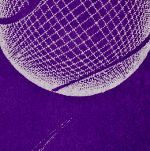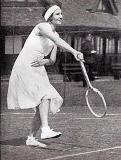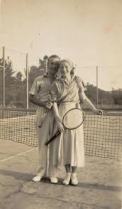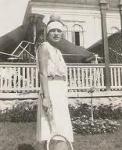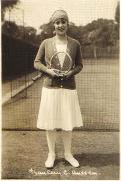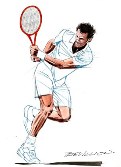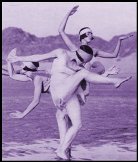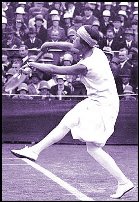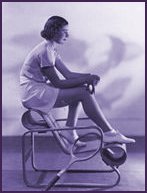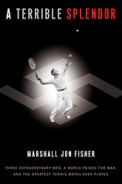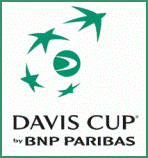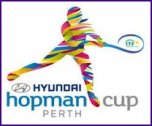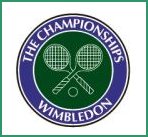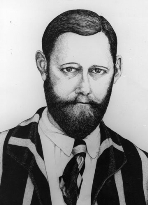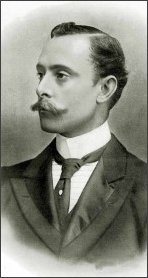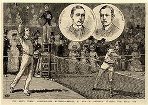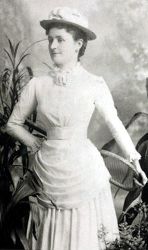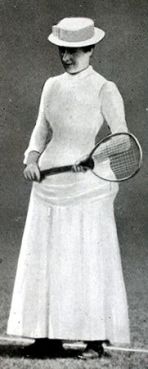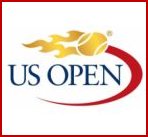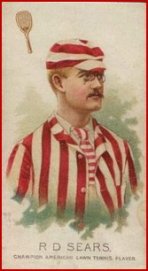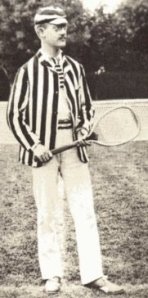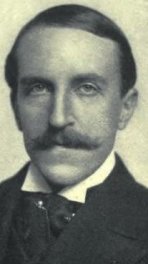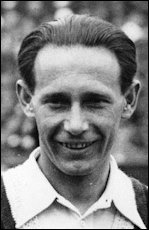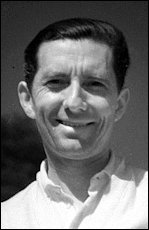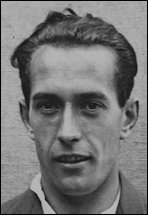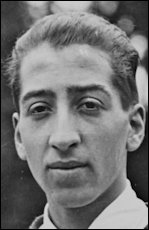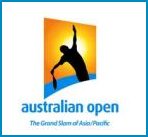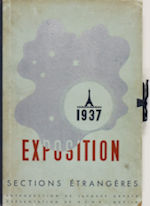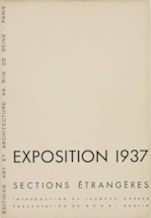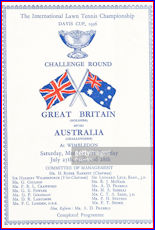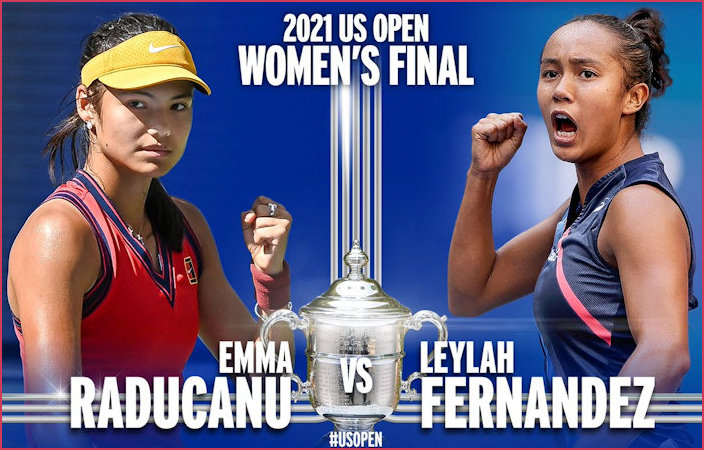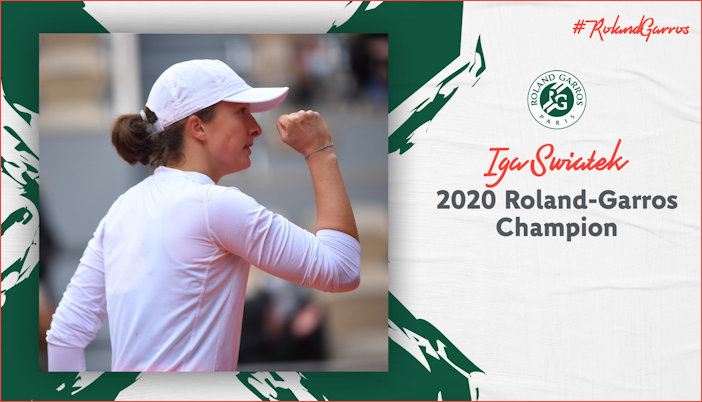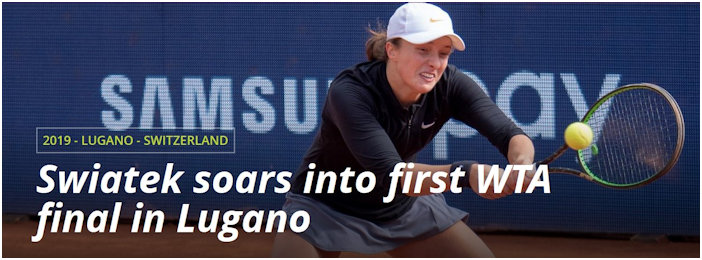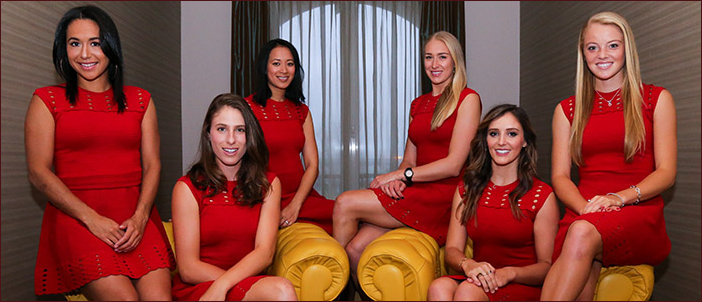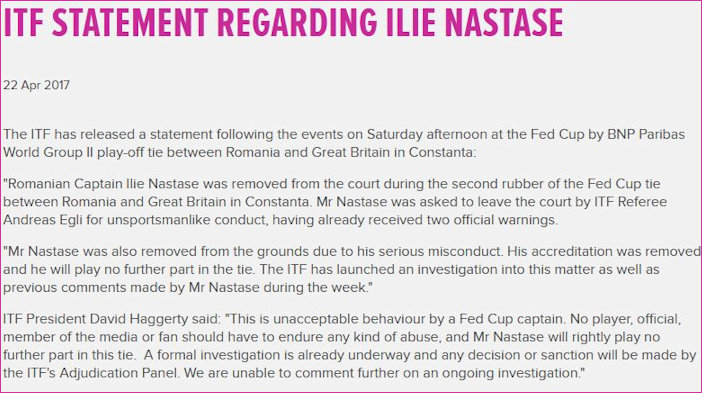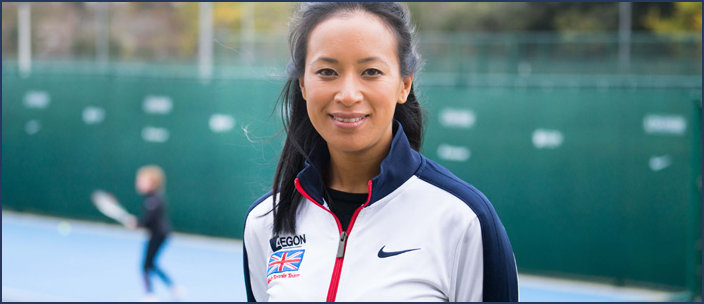Welcome to the Tennis Home Page
Tennis is a bit of a passion of mine, so there may be lots of information here that is relevant or not to actual tennis, but Fashion is always interesting! This is a lovely illustration from the April 1930 (my favourite decade of course) edition of Good Housekeeping and a lovely pose from Senorita de Alvarez in 1927.
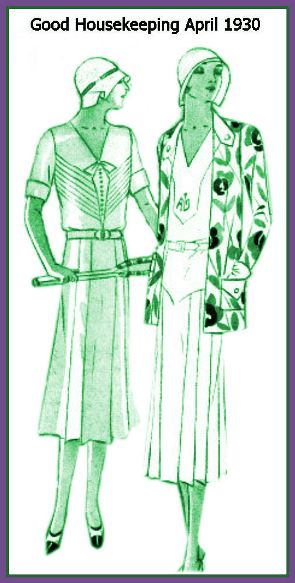
Sourced from Vogue dated 24th June 2016 :
90 Years Later, Suzanne Lenglen, a Six-Time Wimbledon Winner, Still Exemplifies Tennis Chic
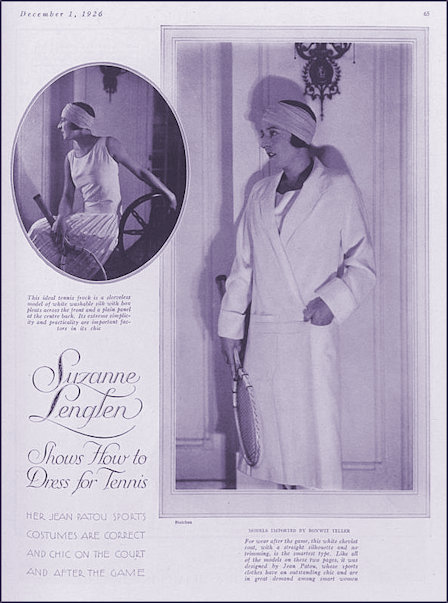
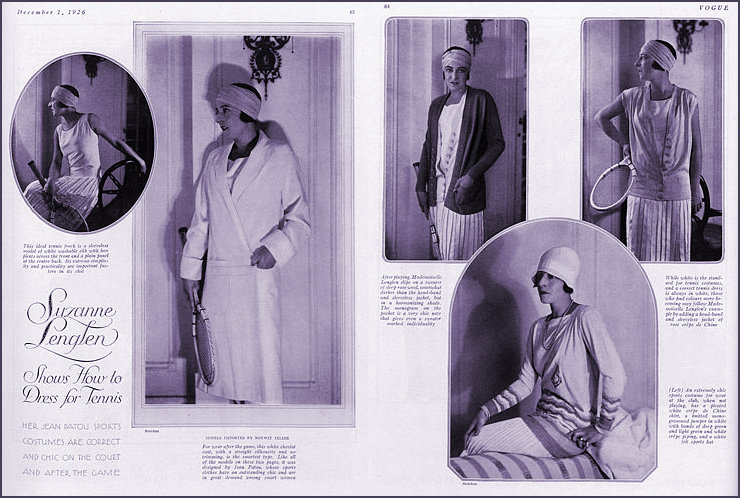
Suzanne Lenglen shows how to dress for tennis her Jean Patou sports costumes are correct and chic on the court and after the game
This ideal tennis frock is a sleeveless model of white washable silk with box pleats across the front and a plain panel at the centre back. Its extreme simplicity and practicality are important factors in its chic.
For wear after the game, this white checked coat, with a straight silhouette and no trimming is the smartest type. Like all of the models on these two pages, it was designed by Jean Patou, whose sports clothes have an outstanding chic and are in great demand among smart women
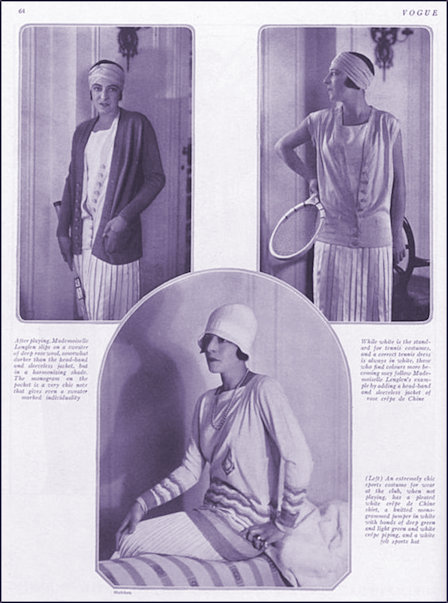
Photographed by Edward Steichen, Vogue, December 1926
That endangered species, the fashion taboo, made a rare appearance at the French Open this year. Unleashed onto the court by Adidas, it took after the zebra, and it made headlines. Tennis hews to tradition in regard to sports dress, so innovations and infractions are newsworthy. Ninety years ago, Vogue held up the star French player Suzanne Lenglen—winner of six Wimbledon titles—as a paradigm of style, noting that “the French champion wears a tennis costume that is extraordinarily chic in the freedom, the suitability, and the excellence of its simple lines.”
Lenglen dressed à la mode, on and off the court, ditching corsets, bustles, and petticoats in favor of sleeveless, and (relatively) short, designer frocks that allowed this “Pavlova of the court to move.” Her “uniform” consisted of a one-piece crepe de Chine pleated dress, and white stockings, British-made “Lenglen shoes” of white doeskin with crepe rubber soles. She kept her nerves in check with brandy, and her black, bobbed hair in place with a bright bandeau, or headache band. (It was her custom, reported The New York Times in 1921, to wear an orange one for her first appearance, and crimson for her second.) After play, she slipped into a monogrammed cardigan. This, like her dress, was made for her by Jean Patou, the soldier and bon vivant designer to whom she had been introduced by Raymond Barbas, an accomplished netman and Patou’s brother-in-law. A rival of Coco Chanel, Patou, an innovative businessman, popularized “la mode sportive.” The same year that Lenglen appeared in Patou fashions in Vogue, the magazine reported that “Three-quarters of daytime fashions offered in Paris are of the sports type. Simple, practical, and youthful, they constitute an influence that is more and more felt outside the realm of active sports in dress for general daytime and resort wear and for travel.” Take that, athleisure! Women, and fashion, were on the move, in ways that anticipated the ’60s youthquake. “There is a new mode in Paris—undisputedly new and different,” reported Vogue in 1929. “And these new fashions are the triumph of the young athletic girl over every one in the world: creators, smart women of acknowledged position, and the dress industry at large.”
Lenglen, the conqueror of the court, changed the way the game was played. She had trained with men and hit harder and faster than her opponents. Temperamental is the adjective most often used to describe her, but perhaps theatrical fits just as well. She knew how to make an entrance and applied the rules of style to her game as well as her life, fully earning her nickname, “La Divine.”
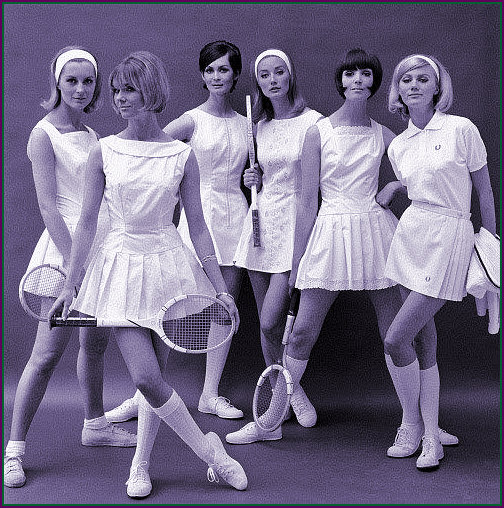
What the fashionable set wore in the 1960s
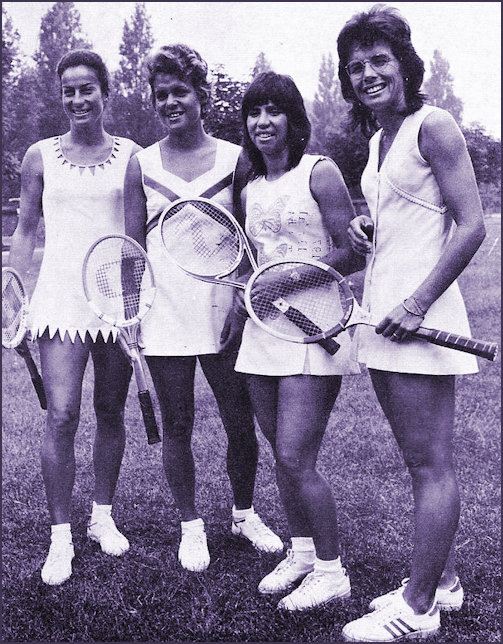
What the stars wore in the 1970s - l to r Virginia Wade (GB), Evonne Goolagong (Australia), Rosie Casals (US) and Billie Jean King (US)
Vogue - 'Tennis style on Court' after Lenglen
Seriously this web-page has chosen some of the worst possible modelling and action shots of tennis stars and female actresses in Tennis attire and way too much Maria Sharapova - what where they thinking (compared to their excellent 90-year article above)? It's a difficult site to load down but worth a look here
Vogue says : "Sisters Venus and Serena Williams and their tennis contemporaries, including Maria Sharapova, Anna Kournikova, and Caroline Wozniacki, often attract as much attention for their outfits as for their backhands. Yet standing out sartorially on the tennis court didn't start with them. From Chris Evert in delicate white lace, to fellow-American Linda Siegel baring almost all at Wimbledon in the Seventies, women in tennis through the ages have been known for their daring style. Even BBC commentator Sue Barker once sported bunches in her hair and a micro-mini dress. See the most talked-about style stars on-court through the years."
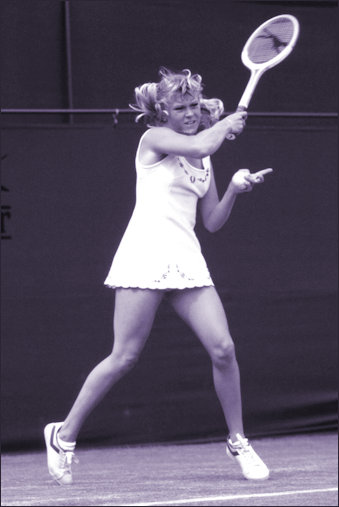
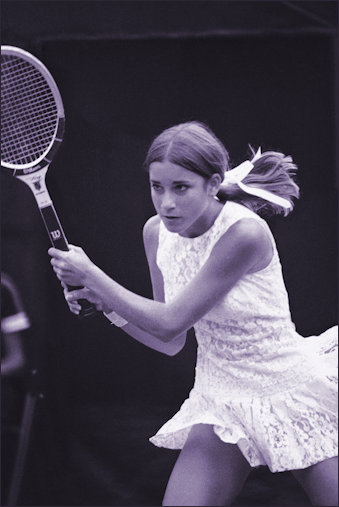
l to r Sue Barker (GB) and Chris Evert (USA) in 1971
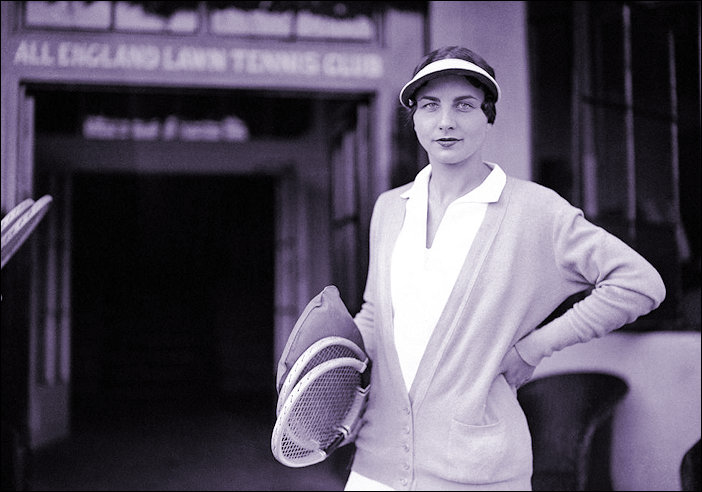
The ever charismatic Helen Wills Moody in 1930
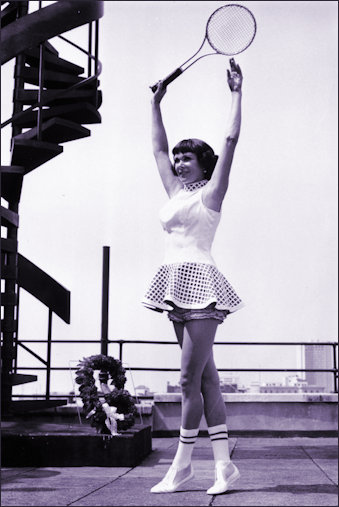
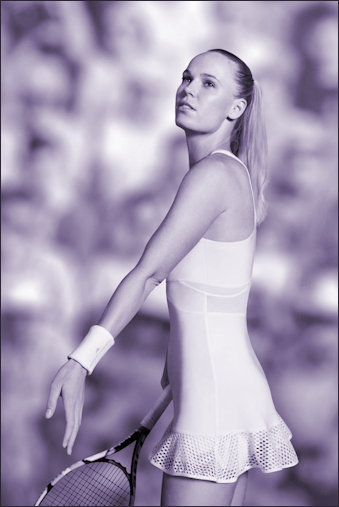
l to r the irrepressible Gussie Moran (USA) in 1963 and representing the 21st century players Caroline Wozniaki (Denmark) in 2015 when she looked more model less athlete!
These are my favourites from the Vogue choices.
2021 - Hurkacz wows them in Metz wining both Singles & Doubles Titles
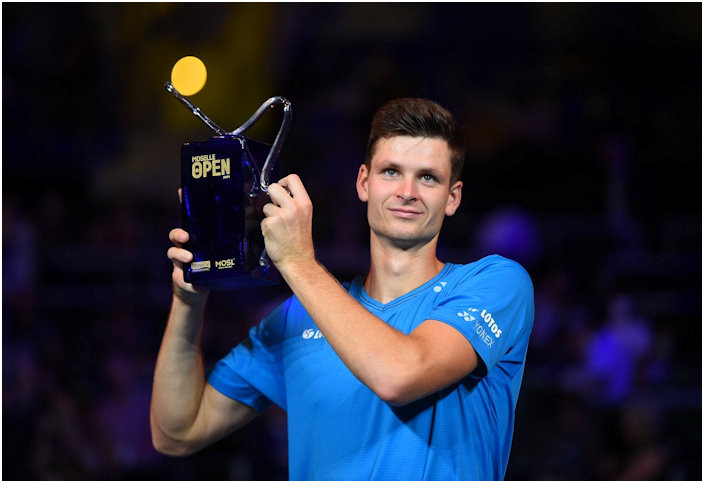
From Hubert's Fb profile - 'It was a great match today! Pablo Carreno-Busta was a very demanding opponent. I had to show my best tennis. I am happy to win #MoselleOpen and thank you all for your support!'
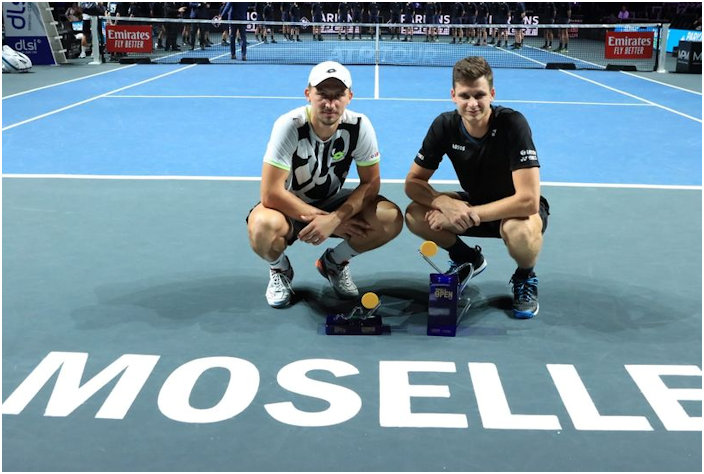
From Hubert's Fb profile - 'It was such an incredible week! I am delighted with the two titles that I won during #MoselleOpen. It turned out to be a special path for me and Jan Zieliński. We've known each other since we were 9 years old, we played together in junior tournaments. On Sunday, we lifted the trophy after winning in Metz. Now it's time for the tournament in San Diego!'
2021 - A coveted trophy for Emma
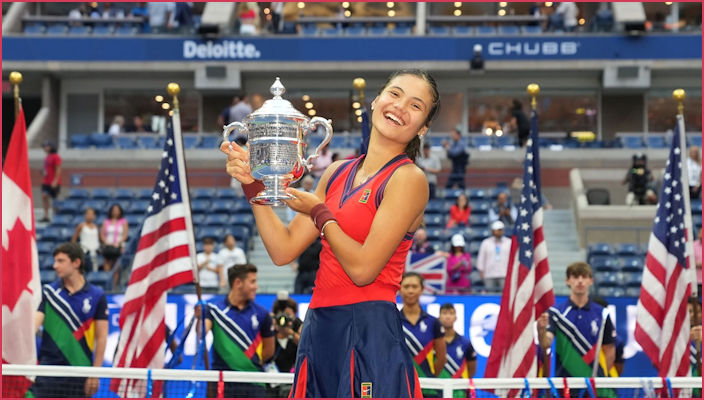
A joyous Emma and her maiden Grand Slam Trophy - what an achievement! Photograph: courtesy & © Robert Deutsch/USA Today Sports and US Open (official site)
2021 - A message from HM the Queen for Emma
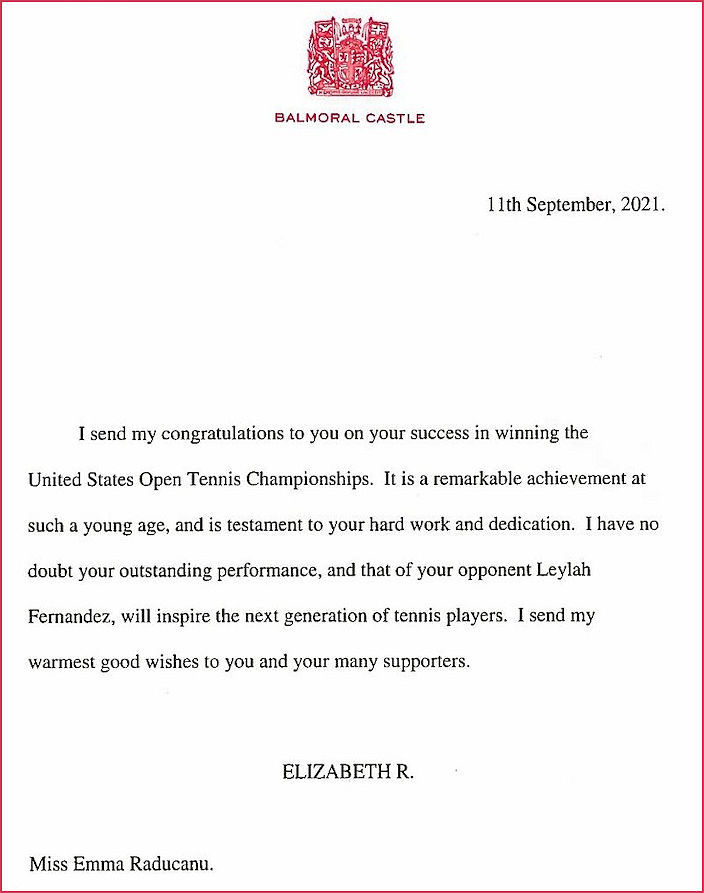
Raducanu said it 'meant everything' to get a letter from the Queen congratulating the teenager on her astonishing US Open championship victory on Saturday and revealed she is planning on framing the note - image & strapline courtesy of the Daily Mail - image © The Royal Family
2021 - A Grand Slam for Emma Raducanu on 9/11
The Protagonists as seen on this US Open poster for 2021 - two teenager combatants, one a qualifier!
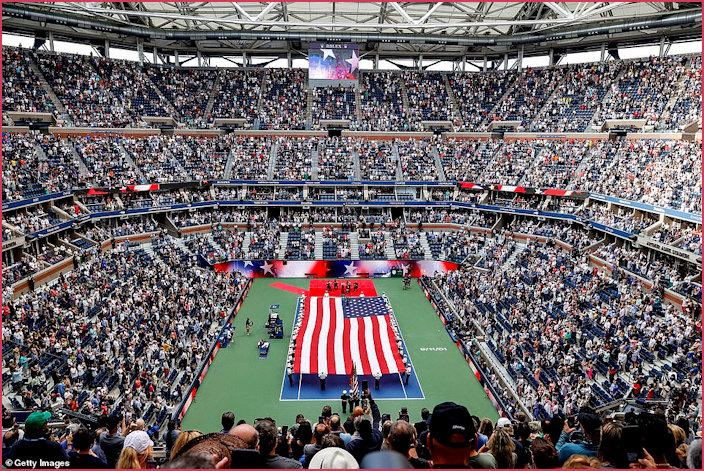
Fans stand for the national anthem at the Arthur Ashe Stadium in New York on Saturday afternoon - image courtesy & © of Getty Images
United States Marine Corps, 6th Communication Battalion, Brooklyn, NY and All-Female Cadets From The United States Military Academy at West Point unfurl the flag during the 9/11 Observance ahead of the Women's Singles championship match at the 2021 US Open, Saturday, 11th September, 2021 in Flushing, NY (Rhea Nall/USTA)
Prior to the Women's Singles Final being played on 11th September 2021 everyone in the stadium paid their respects to the fallen of the 9/11 atrocity which took the world by storm 20 years ago in 2001
2021 - Miami Open: Hubert Hurkacz defeats Jannik Sinner to win his maiden Masters 1000 title

Poland's Hubert Hurkacz won his maiden Miami Open title on Sunday - image sourced from & © of atptour.com
Hubert Hurkacz is the first Pole to win a men's singles Masters 1000 title; the 24-year-old beat Denis Kudla, Denis Shapovalov, Milos Raonic, Stefanos Tsitsipas, Andrey Rublev, and now Jannik Sinner on the way to a stunning tournament victory
Last Updated: 4th April 2021
Poland's Hubert Hurkacz made it a perfect 10-0 in Florida as he added his maiden Masters 1000 title at the Miami Open with victory over teenager Jannik Sinner to the Delray Beach Open crown he won in January. Hurkacz, the first Polish singles player to win one of the ATP's top level of events, continued his brilliant week by beating 19-year-old Italian Sinner 7-6 (7-4) 6-4. "Last year I spent here almost half a year," Hurkacz said in an on-court interview. "I was practising in the hottest weather during the spring and summer here, so I think that helped me a lot playing now in Florida, especially in these pretty tough conditions here, because it was a little bit slow here. The wind was blowing from side to side sometimes, so it's huge."
With Novak Djokovic, Rafael Nadal and Roger Federer all skipping the tournament, the stage was set for an unexpected champion, and so it proved. Hurkacz made the better start, winning the first three games, but Sinner responded with a run of three games of his own to draw level. The prodigiously talented teenager was the youngest Masters finalist since Rafael Nadal and, after withstanding more pressure from Hurkacz, he broke the Pole's serve at 5-5. He was unable to serve out the set, though, and it was Hurkacz who stepped up to take it on a tie-break.
The Pole was flawless at the start of the second set, reeling off four games in a row, but he became a little tight in sight of the finish line and Sinner clawed his way back to 3-4. Source : e0.365dm.com
2020 - Swiatek Honoured by Poland
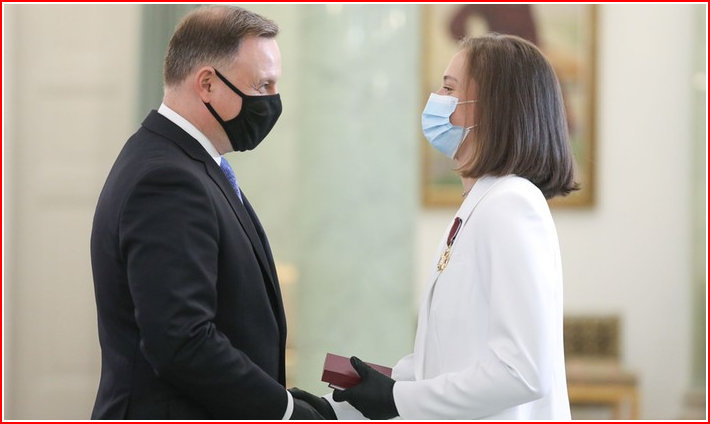
Iga Świątek została odznaczona przez prezydenta Andrzeja Dudę Złotym Krzyżem Zasługi za osiągnięcia sportowe i promocję kraju. On Friday, 23rd October, Iga Świątek received her Gold Cross of Merit for a sporting achievement and promoting Poland internationally.
2020 - The French Open @ 'Poland Garros' featuring Iga Swiatek
Angela Buxton
2020 - Angela Buxton, born 16th August 1934, died 15th August 2020
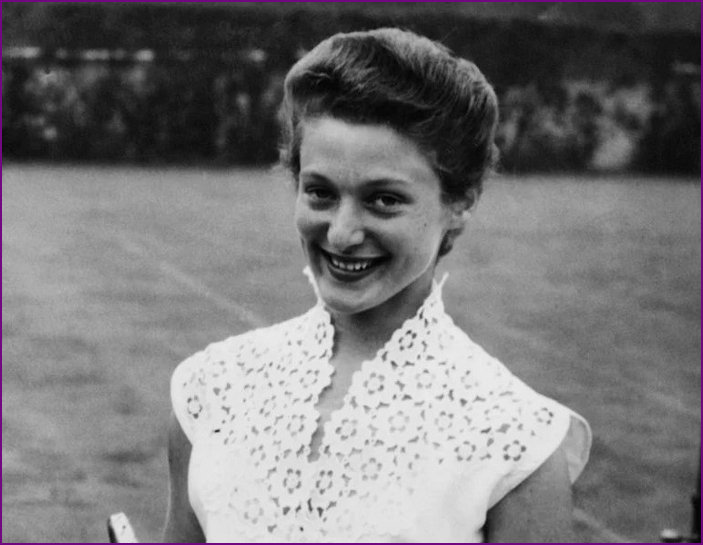
Angela Buxton at the Hurlingham Club in 1955 Credit: Terry Fincher/Hulton Archive
I'm ashamed to say that I knew nothing of this player until I read her truly remarkable life story in the Telegraph's obituary today. I hope I have rectified this by reproducing it in full on my favourite players page (she certainly would have been a favourite for her altruism alone as I doubt much footage of her game remains) - RIP
2020 - Cancellation of the Championships
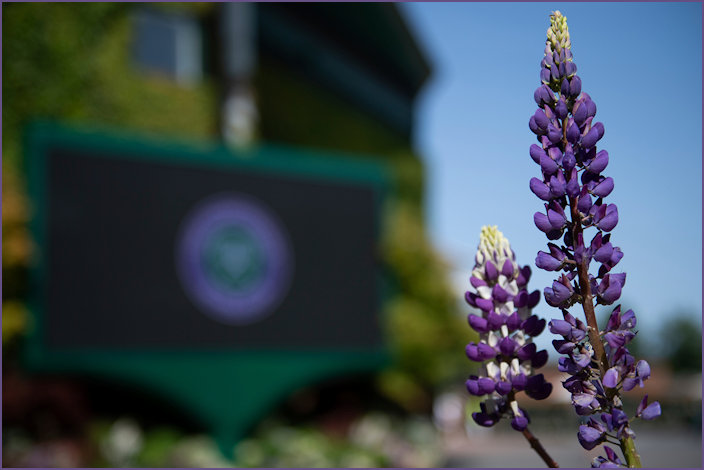
Image sourced from and as it appears on the official website © AELTC
It is with great regret that the Main Board of the All England Club (AELTC) and the Committee of Management of The Championships have today decided that The Championships 2020 will be cancelled due to public health concerns linked to the coronavirus epidemic. The 134th Championships will instead be staged from 28 June to 11 July 2021.
Uppermost in our mind has been the health and safety of all of those who come together to make Wimbledon happen – the public in the UK and visitors from around the world, our players, guests, members, staff, volunteers, partners, contractors, and local residents – as well as our broader responsibility to society's efforts to tackle this global challenge to our way of life. Since the emergence of the coronavirus (COVID-19) outbreak in January, we have followed guidance from the UK Government and public health authorities in relation to our year-round operations, alongside developing an understanding of the likely trajectory of the outbreak in the UK. This has enabled analysis of the impact of the Government restrictions on the usual commencement in April of the significant preparations required to stage The Championships, either on the original date of 29 June, or at a later date in the summer of 2020. These considerations are particularly related to the concerns brought about by mass gatherings and the strain on the medical and emergency services, as well as movement and travel restrictions both within the UK and around the world. With the likelihood that the Government's measures will continue for many months, it is our view that we must act responsibly to protect the large numbers of people required to prepare The Championships from being at risk – from the training of ball boys and girls to thousands of officials, line judges, stewards, players, suppliers, media and contractors who convene on the AELTC Grounds – and equally to consider that the people, supplies and services legally required to stage The Championships would not be available at any point this summer, thus ruling out postponement.
Following a series of detailed deliberations on all of the above, it is the Committee of Management's view that cancellation of The Championships is the best decision in the interests of public health, and that being able to provide certainty by taking this decision now, rather than in several weeks, is important for everyone involved in tennis and The Championships. Members of the public who paid for tickets in the Wimbledon Public Ballot for this year's Championships will have their tickets refunded and will be offered the chance to purchase tickets for the same day and court for The Championships 2021. We will be communicating directly with all ticket-holders. In addition, we have taken account of the impact that this decision will have on those who rely on The Championships – including the players and the tennis community in Britain and around the world – and we are developing plans to support those groups, working in partnership with the LTA and the other leadership bodies in global tennis. This also applies to our loyal staff, to whom we take our responsibility very seriously. Ian Hewitt, AELTC Chairman, commented: "This is a decision that we have not taken lightly, and we have done so with the highest regard for public health and the wellbeing of all those who come together to make Wimbledon happen. It has weighed heavily on our minds that the staging of The Championships has only been interrupted previously by World Wars but, following thorough and extensive consideration of all scenarios, we believe that it is a measure of this global crisis that it is ultimately the right decision to cancel this year's Championships, and instead concentrate on how we can use the breadth of Wimbledon's resources to help those in our local communities and beyond. Our thoughts are with all those who have been and continue to be affected by these unprecedented times."
Richard Lewis CBE, AELTC Chief Executive, commented: "While in some ways this has been a challenging decision, we strongly believe it is not only in the best interests of society at this time, but also provides certainty to our colleagues in international tennis given the impact on the grass court events in the UK and in Europe and the broader tennis calendar. We have appreciated the support of the LTA, and the ATP, WTA and ITF in coming to this decision, and our friends and partners who stage these grass court events that are so important in the build up to Wimbledon. I would like to thank the UK Government and public health authorities for their guidance and support, and we will do whatever we can to assist their efforts in tackling the crisis. "Finally, I would like to thank all those who love Wimbledon for their understanding of these unique and unquestionably challenging circumstances. It is your passion for The Championships that has shaped our event over the years, and will continue to do so, and we look forward to preparing a fantastic Championships for 2021." Our efforts will now be focused on contributing to the emergency response and supporting those affected by the coronavirus crisis. We have begun distributing medical equipment and offered the use of our facilities to the NHS and to the London Resilience Partnership, the collection of agencies in London fighting the battle against COVID-19. We are working with the local authorities in Merton and Wandsworth, particularly on food distribution, and we are distributing food supplies through our partnership with City Harvest. Our charity, the Wimbledon Foundation, is offering funding support to our local communities through our partnership with the London Community Foundation, and more broadly for the London and UK population through our partnership with the British Red Cross, the Foundation's emergency response charity.
2019 - The Incoming Face of Polish Tennis
Polish teenager Iga Świątek put on a brilliant performance to reach her first career WTA final at the Samsung Open presented by Cornèr, losing just one game against Kristyna Pliskova.
Sue Barker Honoured With 2018 Ron Bookman Media Excellence Award
The BBC's Sue Barker was presented the Ron Bookman Media Excellence Award, in the 2018 ATP World Tour Awards presented by Moët & Chandon, from ATP Executive Chairman & President Chris Kermode during the Nitto ATP Finals. - Image and caption © and sourced from the ATP
2018 - The departing face of Polish Tennis
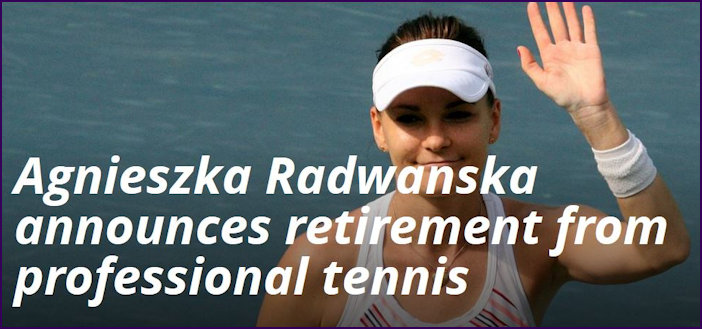
The WTA announcement of Aga's retirement from her professional career - they say "A history-maker for Polish tennis, the former Wimbledon finalist and World No.2 has decided to hang up her racquet."
2018 - The new face of Polish tennis?
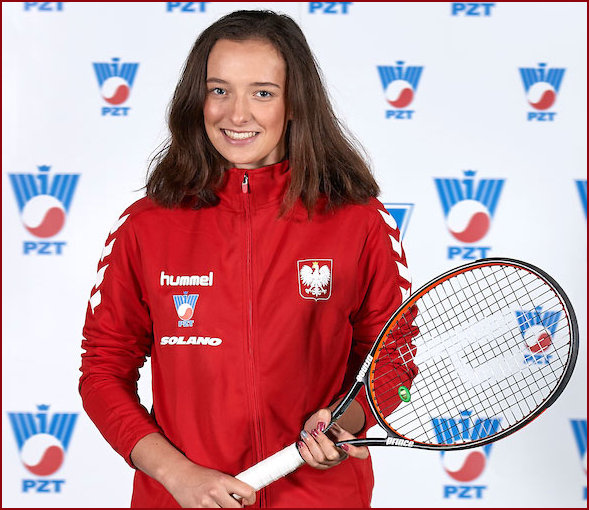
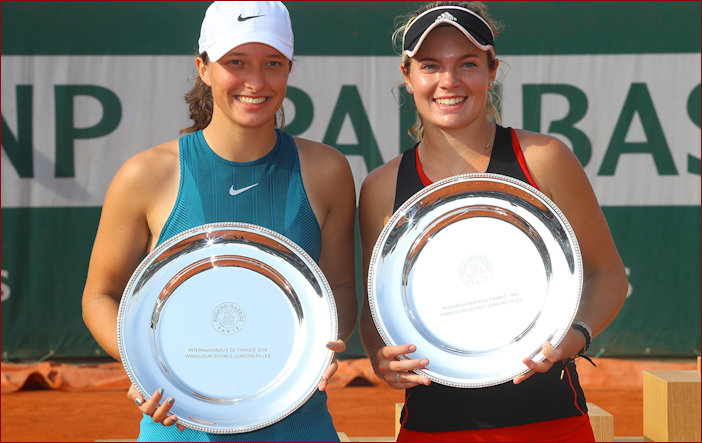
Meet Iga Świątek - Girls Doubles Champion and Singles semi-finalist at the 2018 French Open - top image courtesy & © of sportsgroup.pl / Iga and Caty McNally with trophies image sourced from & © of Roland Garros.com
2017 - Federation Cup Debacle
It started so well ......
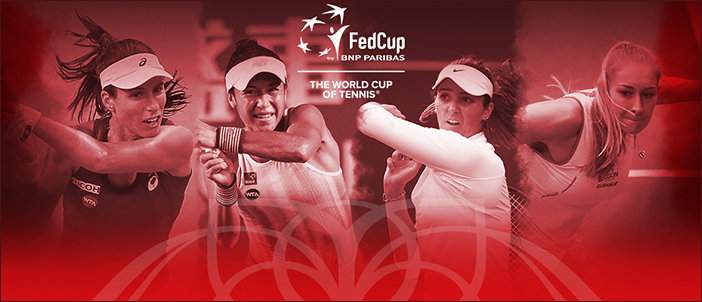
Team GB from l to r : Johanna Konta, Heather Watson, Laura Robson and Jocelyn Rae
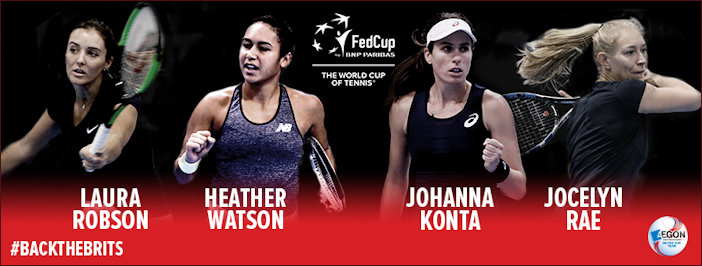
Power Girls! - Read more here
Team Glamour GB from l to r : Heather Watson, Johanna Konta, Anne Keothavong (captain), Jocelyn Rae, Laura Robson and Katie Swann - images courtesy and © of the LTA
Aegon GB Fed Cup Captain Anne Keothavong has named the strong four who will line up against Romania in the coastal town of Costanta for the Fed Cup World Group II Play-Off on April 22 - 23.
The four named players include British No. 1 Johanna Konta, No. 2 Heather Watson, singles player Laura Robson and GB’s top doubles player Jocelyn Rae. The team is unchanged from the quartet that emerged victorious from the Euro/Africa Zone Group I event in Estonia in February.
Quotes from the captain
Commenting on the announcement, Aegon GB Fed Cup Captain and LTA Senior National Coach Anne Keothavong said: “I am delighted to name the same team who represented us so strongly back in February for our group wins in Estonia to enable us to get through to this play-off. "Fed Cup is a unique privilege to wear your nation’s colours and it’s something I know all of our team takes great pride in. This is the first time in four years we are in this position and I know everyone is excited by the opportunity.
"We have an excellent team spirit with lots of combined Fed Cup experience"
"Romania has a first class team and will have home advantage on their best surface. We are very much the underdogs. That being said, we have an excellent team spirit with lots of combined Fed Cup experience, added to the fact that women’s tennis has not had a higher profile in the UK in nearly 40 years.
..... and descended into mayhem!
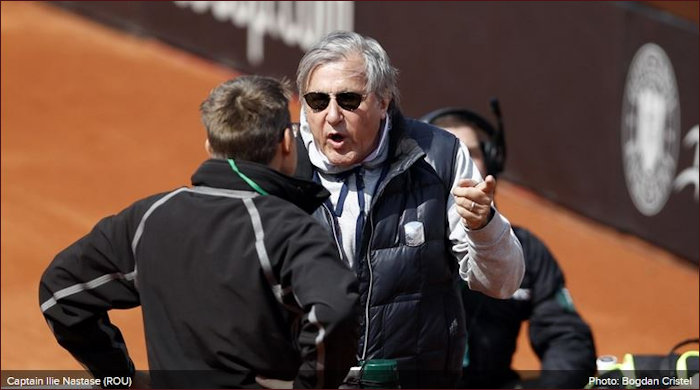
Nastase verbally abusing a court official prior to being escorted out of the arena - image courtesy and © of the FedCup and Bogdan Cristel
Romania captain Ilie Nastase was banned from the Fed Cup tie against Britain after an incident that left Johanna Konta in tears and her match suspended. In Konta's match against Sorana Cirstea, Nastase was sent off after swearing at the umpire and abusing Konta and her captain Anne Keothavong. The world number seven lost her serve in the next game and was visibly upset before play was halted for 25 minutes.
The International Tennis Federation is investigating Nastase's conduct.
The world governing body said it was looking into "this matter as well as previous comments made by Mr Nastase during the week".
Read more on the BBC and the Daily Telegraph websites
2017 Jo Konta triumphs in Miami
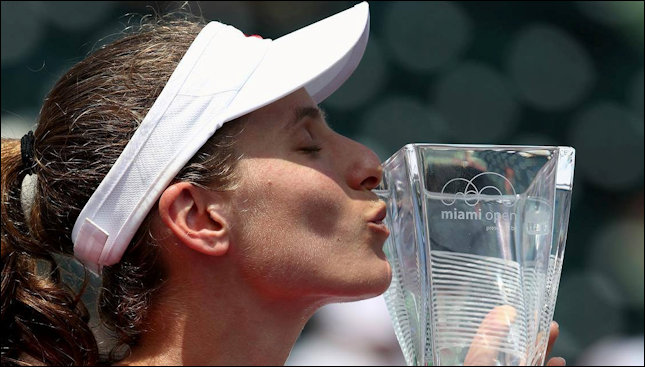
Image courtesy of the Team GB website - see more
2017 Davis Cup GB v Canada
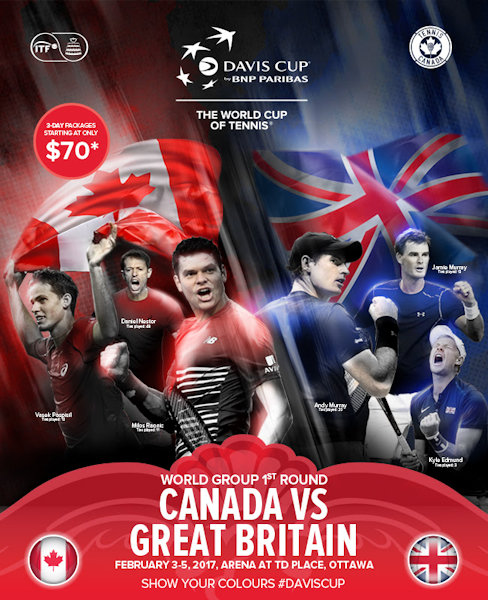
Image courtesy of The National Capital Tennis Association - neither Milos Raonic (Canada) nor Andy Murray (GB) played in the tournament
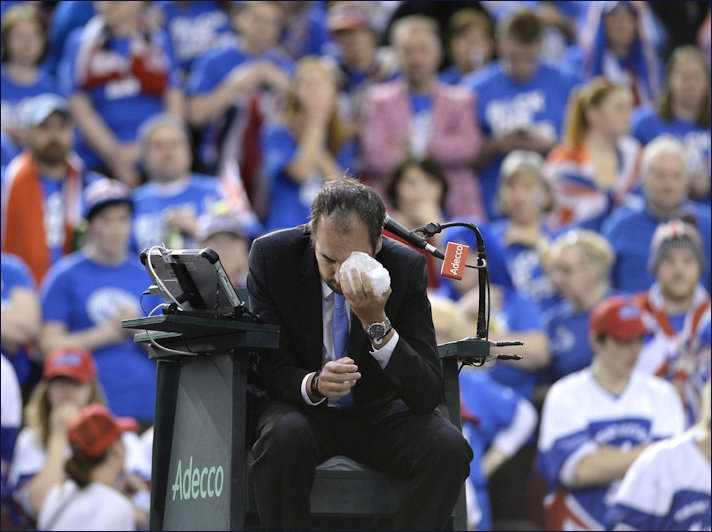
Umpire Arnaud Gabas, of France, holds his face after being hit by a ball during first-round Davis Cup tennis match action between Canada's Denis Shapovalov and Britain's Kyle Edmund, Sunday, Feb. 5, 2017, in Ottawa, Ontario. (Justin Tang/The Canadian Press via AP)
What a start to proceedings - in the nail biting 5th set the Canadian player (Junior Wimbledon Champion) scores an own goal by taking out the Umpire with a fit of temper right in front of the adoring GB fans!
Ball hits Davis Cup umpire in face, Canada loses to Britain
Published: February 6, 2017 9:31 AM CDT Updated: February 6, 2017 9:31 AM CDT
OTTAWA, Ontario (AP) — In a startling ending to a Davis Cup match, Canada lost to Britain on Sunday when a 17-year-old player, frustrated by missing an easy shot, suddenly launched a spare ball that hit the chair umpire in the left eye.
Britain advanced to the World Group quarterfinals with Kyle Edmund's 6-3, 6-4, 2-1 default victory over Denis Shapovalov in the decisive fifth match. Shapovalov had just been broken by Edmund, hitting wide on a simple backhand, when he took a ball out of his pocket and wildly smacked it. The ball struck umpire Arnaud Gabas of France in the face, and the contact resulted in an automatic default. Gabas put ice under his eye as swelling and bruising began and was taken to Ottawa General Hospital for a precautionary evaluation. Shapovalov immediately came over to check on Gabas after the accident and appeared to be shaken, holding his head in a towel.
"Obviously this is unacceptable be ha vi or from me," Shapovalov said. "I just feel awful for letting my team down, for letting my country down, for acting a way that I would never want to act." "I can promise that's the last time I will do anything like that," he said. The crowd of 7,497 at TD Place was stunned by the turn of events. Team Canada captain Martin Laurendeau had never dealt with a similar situation.
"He's not that kind of guy. It's just the beginning of his career, so he'll draw a big lesson out of this," Laurendeau said. "Curbing your emotions on the court is probably something that he'll need to make a living out of this sport. You can't compete if you don't have emotional control and this lesson can serve him for the rest of his career and the rest of his life." The first-round victory moved Britain into a meeting with France in the quarters. Britain is assured a spot in the World Group next year while Canada must win a World Group playoff tie to keep its spot for 2018.
Vasek Pospisil defeated Britain's Daniel Evans 7-6 (3), 6-4, 3-6, 7-6 (5) earlier Sunday, tying the match up at 2-all. Pospisil said Shapovalov's action was out of character. "No one is nicer or carries themselves better for a 17 y/o than Shapovalov. Everyone can see that today was an accident. Can happen to anyone," Pospisil tweeted.
Britain team captain Leon Smith called the turn of events "a shame." "I feel sorry for Denis. He's gotten a harsh lesson," Smith said. "He'll learn, I'm sure. But firstly I hope the umpire's OK. That can be really dangerous."
Source : NewsOK - for more read the Ottowa Sun
2016 - Anne Keothavong appointed Federation Cup Captain
Anne Keothavong - image courtesy and © of the Lawn Tennis Association
Anne Keothavong named Senior National Women's Coach and Fed Cup Captain
29/11/2016
"The Lawn Tennis Association is pleased to confirm the appointment of Anne Keothavong to the role of Senior National Women’s Coach. The position will involve working with Head Coach Women’s Tennis Jeremy Bates in overseeing the development and delivery of individual support programmes for aspiring professional players, as well as preparation and management of the Aegon GB Fed Cup team in the role of Captain. Keothavong will start December 1 and will travel out to the Australian Open in preparation for the Fed Cup Euro/Africa Zone Group 1 (February 7-12) in Tallinn, Estonia.
Jeremy Bates, LTA Head Women’s Coach, said: “We have found the best candidate in Anne. She has a tremendous work ethic having gone through triumph and adversity in her own career, and has a burning desire to give back to British Tennis.” Keothavong stated: “I’m delighted and honoured to accept this position in the sport that I love. What a privilege it’s been to see all the British success on the court over the last couple of years, especially this last 12 months. But success doesn’t just happen, it takes hard work, dedication, commitment and a desire to continually do better.” Current British No.1 and Britain’s first WTA Top 10 year-end finisher since 1983, Jo Konta commented: “I think Anne is a great choice as our next [Aegon] GB Fed Cup captain. She will lead from real life experience because she was a winner on court and she knew what it took to step up and play for her country. I wish her the best and look forward to the 2017 campaign.”
As a professional player, Anne won 20 singles titles from 2001-2013 across all levels on the ITF Women’s Pro Circuit. On the WTA, Keothavong was a runner-up in doubles at Florianopolis and a seven-time singles semi-finalist, including the WTA Premier stop at 2009 Warsaw. That same year in February, she became the first woman since Jo Durie 16 years earlier, to break into the world’s Top 50. Keothavong had an illustrious and long-standing Fed Cup playing career.
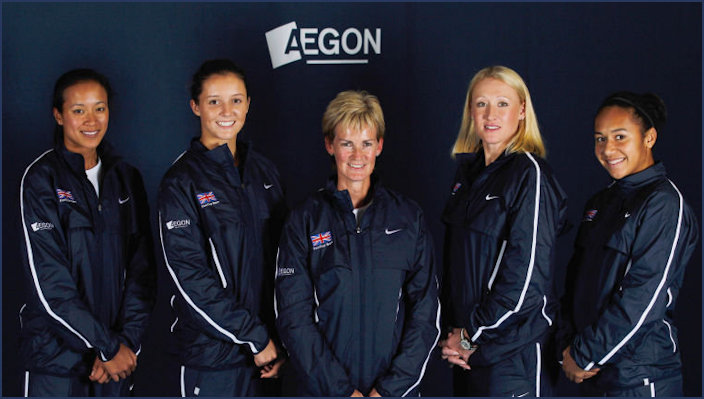
l to r - Anne Keothavong, Laura Robson, Judy Murray, the late Elena Baltacha and Heather Watson - image courtesy and © Sky Sports - read more here
She first represented her country in 2001, playing in all years of the tournament, apart from 2002, during her 13-year pro career. Aged 17 years, 221 days, Keothavong was the youngest Briton to represent her country in Fed Cup, in a 52-year span until Katie Swan (270 days younger) broke that record in 2016. Only Virginia Wade has donned the Union Jack more in the competition than Keothavong’s 40 ties. She played 44 singles and doubles Fed Cup rubbers in that time. Her record of 21 singles wins in the competition is only bettered by Wade (with 36)." Full report here
2016 - Murray becomes 26th Player in History to hold No. 1 in ATP Rankings
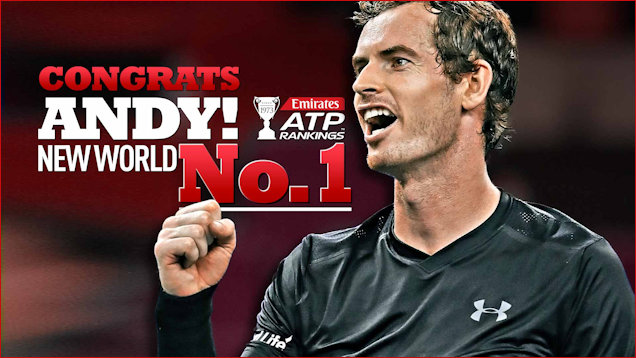
Briton ends Djokovic’s reign atop Emirates ATP Rankings. (Follow link for full article and here for the BBC)
More than seven years after he first ranked No. 2, Great Britain’s Andy Murray will take over the No. 1 position in the Emirates ATP Rankings on Monday, replacing Novak Djokovic, who has held the top spot since 7 July 2014. Murray will now battle Djokovic for the coveted year-end No. 1 at the Barclays ATP World Tour Finals.
Murray was guaranteed to move to No. 1 for the first time as a result of reaching the BNP Paribas Masters final in Paris on Saturday (05.11.2016). Djokovic had been No. 1 for the past 122 weeks since 7 July 2014, and 223 weeks overall. Murray, who has spent 76 weeks at No. 2 since first reaching the mark in 2009, is the first British male to rank No. 1 in the history of Emirates ATP Rankings (since 23 August 1973). On Monday (07.11.2016), at 29 years, 5 months and 23 days, the Dunblane native will be the 26th player in the history of the Emirates ATP Rankings (since 1973) and the second-oldest player (John Newcombe, 30 years, 11 days, on 3 June 1974) to debut at No. 1 in the official rankings in men's tennis. He is the 15th European player to rank No. 1 and owns the ATP World Tour record for most time between becoming No. 2 and No. 1, having debuted at No. 2 on 17 August 2009.
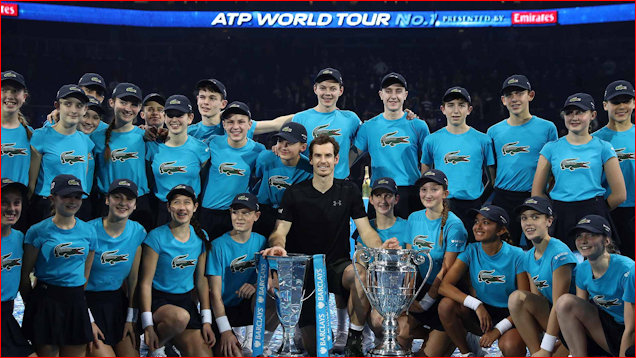
ATP Executive Chairman & President Chris Kermode said, “Andy has shown incredible dedication, determination and hard work in his bid to get to No.1. It’s difficult to think of a player more deserving of this accolade, what is more in one of the toughest eras in the history of our sport. He has had a phenomenal season and fully deserves this latest recognition, which confirms his status as the best player in the world.” This year, his brother, Jamie Murray, rose to No. 1 in the Emirates ATP Doubles Rankings for the first time on 4 April 2016 and held the top spot, in two stints, for a total of nine weeks.
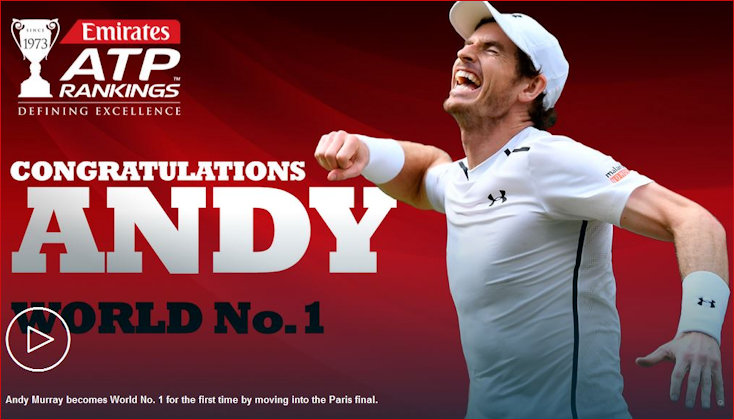
All images courtesy and © of the ATP
2016 - Which was Wimbledon's sexiest decade?
Take your pick - this Daily Mail article available here starts with the Sue Barker and Chris Evert era and continues through blonde favourites Anna Kournikova, Carling Basset Seguso, Gabriela Sabatini (an exception with Ana Ivanovic to the blondes), Steffi (now Stefani Graf), Maria Kirilenko, Eugenie Bouchard and those of Czech and Polish descent Hantuchova, Wozniaki, Radwańska (Ula is noticeably absent) and others. The earlier models of the 1970s are class personified on court but the 21st century maidens are honed to model proportions, like I said - take your pick! As for me - well it's these three :
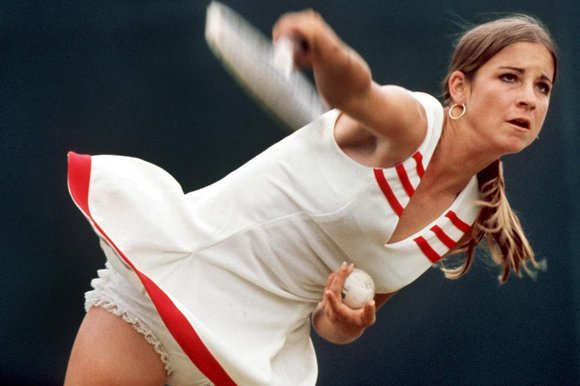
For an athlete on the move Chris Evert rarely had a hair out of place as this image shows
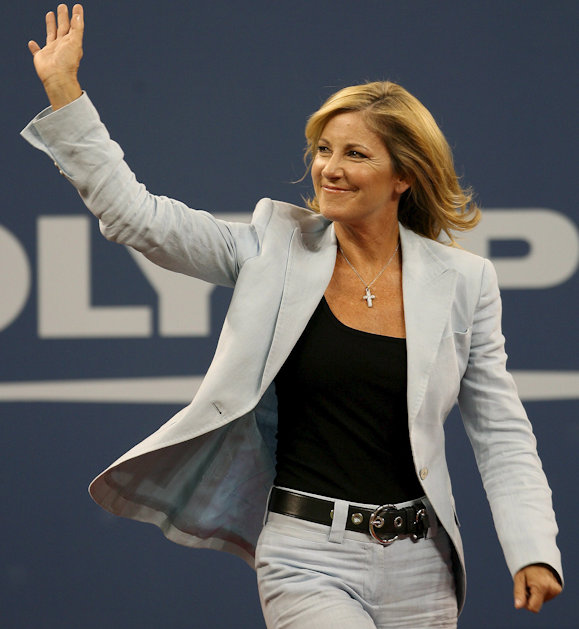
A few decades on - Chris looks fresh as a daisy
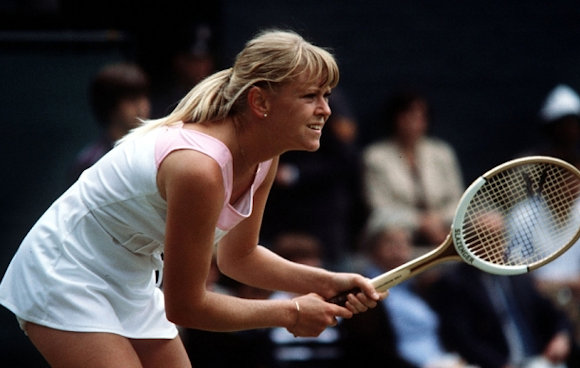
Sue in action a picture of concentration and elegant strength
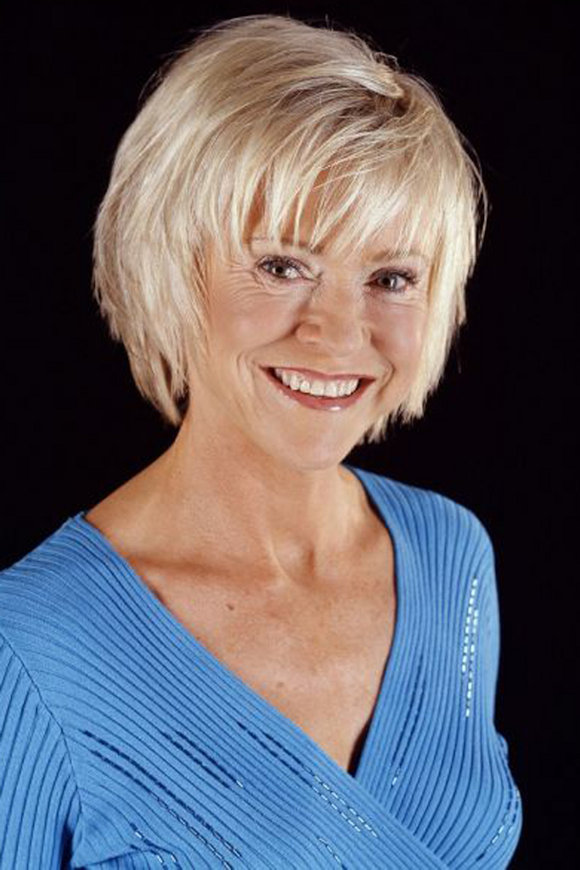
A few decades on - elegant and instantly recognisable as the face of BBC Sport and Tennis
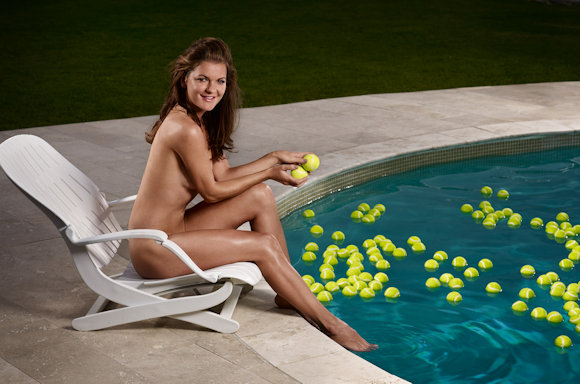
Not Aga's finest moment - but the body is honed to perfection - this pose caused quite a sensation and resulted in Aga losing her 'role as an ambassador for a Catholic Youth Group.'
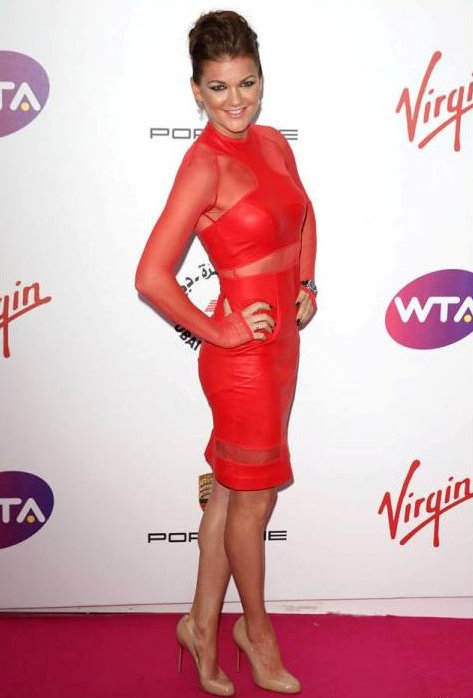
I've never been a big fan of Aga's off court choice of dress, she does so love her 'cutaways' and mesh - but you get no argument from me that she 'scrubs up well!'
2016 - History in the making!
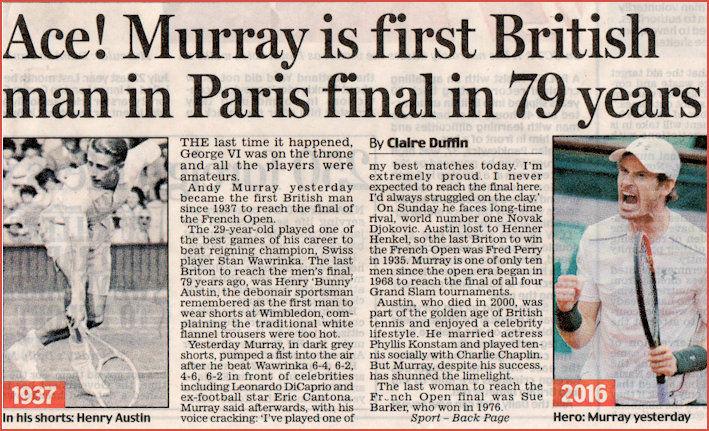
History was made but not by Andy Murray - as Novak Djokovic lifted the Coupe des Mousquetaires for the first time in his career he also became the first man to hold all four Grand Slam titles at once since Rod Laver in 1969.
2016 - Roland Garros - Tennis Elite
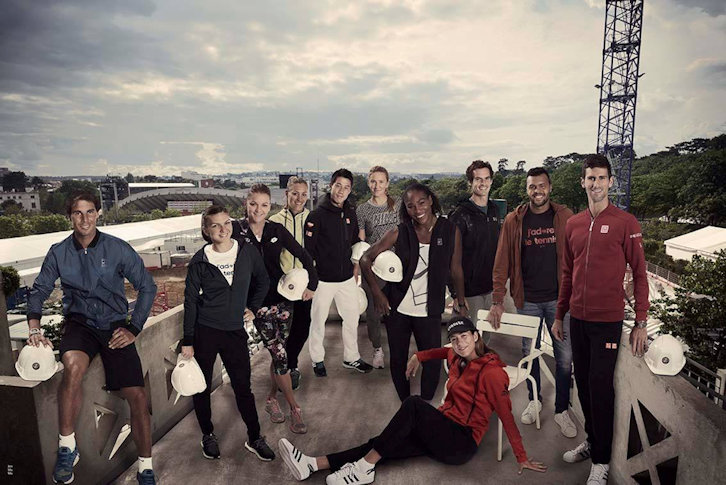
Let's support the #NouveauRolandGarros stadium project! So say l to r - Rafael Nadal, Sabine Halep, Agnieszka Radwańska, Angelique Kerber, Kei Nishikori, Vikka Azarenka, Andy Murray, Jo Wilfrid Tsonga, Novak Djokovic (front and centre) Serena Williams, Garbine Muguruza representing Spain, Romania, Poland, Germany, Japan, Bielorus, UK, France, Serbia and the USA
UK - Davis Cup 2016 Winners!
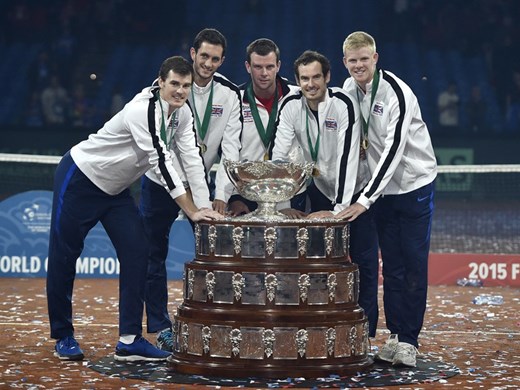
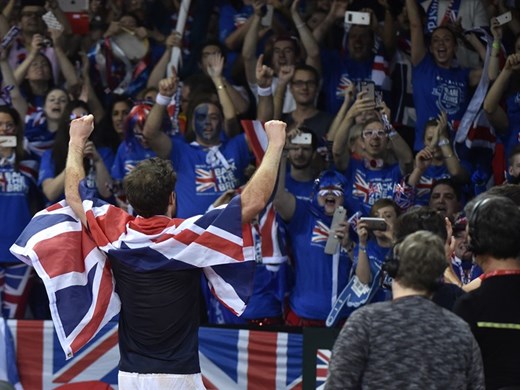
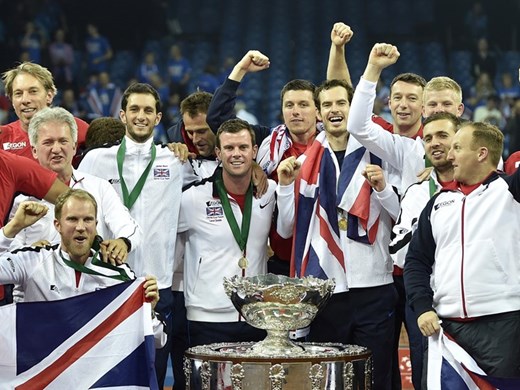
Images courtesy and © of The Davis Cup - Photographer Paul Zimmer
Biggest ever win for Agnieszka Radwanska - Singapore 2015
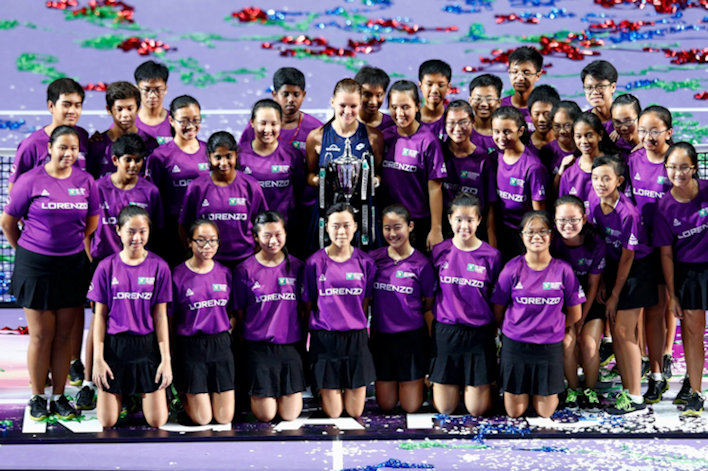
UK - Davis Cup 2015 Finalists
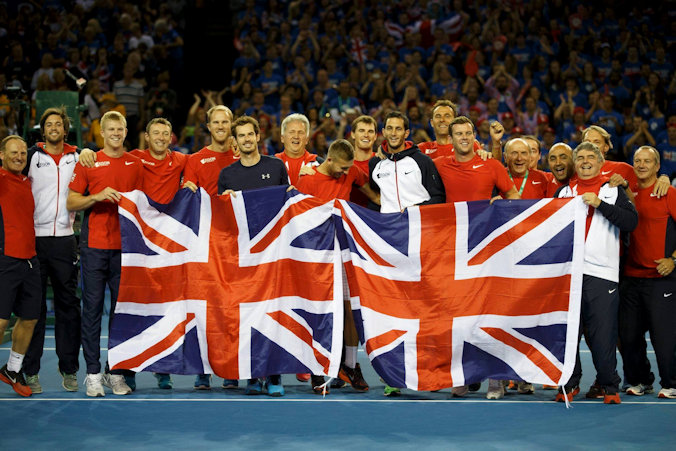
Hopman Cup 2015 - Winners
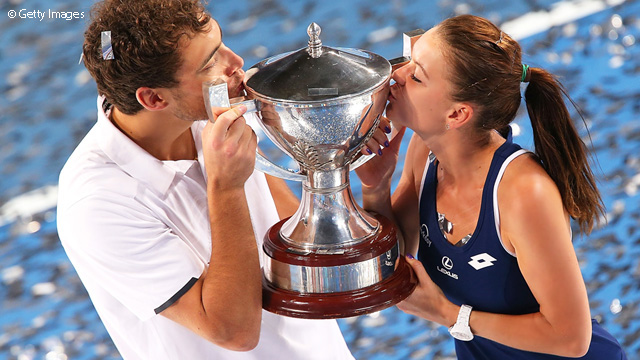
Jerzy Janowicz and Agnieszka Radwanska - Hopman Cup 2015 Champions
Hopman Cup 2014 - Runners Up
Radwanska zagra z Janowiczem w Pucharze Hopmana!
This is how the home page looks currently (August 20th 2013) - prior to this the French team of Marion Bartoli and Jo-Wilfried Tsonga featured in the prime spot before Marion announced her retirement.
(Radwanska and Janowicz to compete in the Hopman Cup)
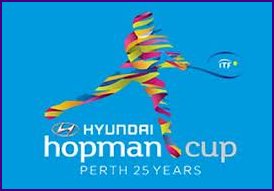
As this is a first appearance by a Polish team it marks yet another great stride in Polish tennis and is worthy of recording on this page.
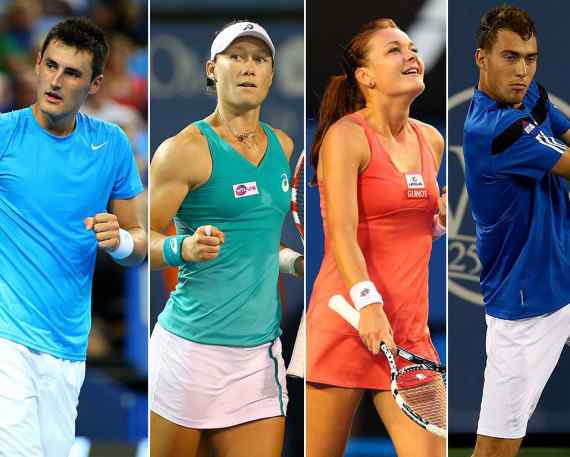
From left to right : Bernard Tomic and Sam Stosur representing Australia and Agnieszka Radwańska and Jerzy Janowicz representing Poland
Po raz pierwszy w historii tenisowa reprezentacja Polski wystąpi w Hopman Cup. W składzie naszego zespołu znaleźli się najwyżej notowany w rankingu ATP Polak Jerzy Janowicz (14 ATP) i czwarta tenisistka świata Agnieszka Radwańska. Udział Polski w nieoficjalnych mistrzostwach świata par mieszanych potwierdzili organizatorzy turnieju.
Jestem bardzo podekscytowana grą w Pucharze Hopmana. Wystąpię tam po raz pierwszy w życiu. Jeszcze nigdy wcześniej nie grałam w grze mieszanej z Janowiczem. Poza tym, mój ostatni mecz tego rodzaju grałam jakieś pięć lat temu. Jestem jednak pewna, że to będzie wspaniała zabawa i spore wyzwanie. Co więcej będzie to dobre przetarcie przed wielkoszlemowym Australian Open. – powiedziała 24-letnia Radwańska.
22-letni Janowicz rozgrywa obecnie jeden z najlepszych sezonów w karierze. Po tym jak w zeszłym roku dotarł do wielkiego finału turnieju rangi ATP World Tour Masters 1000 w paryskiej hali Bercy, systematycznie poprawia swoją pozycję w rankingu. Jak na razie doszedł do czternastego miejsca na świecie, ale jak sam mówi stać go na wiele więcej.
Zdecydowaliśmy się wystąpić wraz z Agnieszką w tej imprezie myśląc, że to może być całkiem niezła zabawa zagrać razem przeciwko czołowym zawodnikom i zawodniczkom. - powiedział szczęśliwy Janowicz.
Dyrektor Hyundai Hopman Cup Steve Alayes jest zachwycony tym, że udało mu się namówić do gry w nieoficjalnych mistrzostwach świata polską parę.
Jesteśmy bardzo podekscytowani tym, że udało nam się namówić do gry tak utytułowanych tenisistów jak Janowicz i Radwańska. Oboje dodadzą naszej imprezie dużo kolorytu i prestiżu. W końcu są jednymi z najlepszych na świecie. Tegoroczny Hopman Cup zapowiada się bardzo interesująco. Będziemy mieli jedną z najmocniejszych obsad w historii. - powiedział uradowany dyrektor imprezy.
W Hyundai Hopman Cup 2014 wystąpi tak mikst australijski. Składać się on będzie z mistrzyni US Open Samanthy Stosur (13 WTA) i najmłodszego Australijczyka notowanego w czołowej setce rankingu ATP Bernarda Tomica (52 ATP). Stosur powróci do Australii Zachodniej po czteroletniej przerwie. Trzynasta tenisistka świata jest niezmiernie szczęśliwa, że będzie mogła ponownie reprezentować swój kraj w tych rozgrywkach.
Bardzo chciałam wrócić do Perth (tam będą rozgrywane spotkania ? TenisNET). Pomyślałam, że w tym roku ponownie chciałabym spróbować czegoś nowego. To będzie dla mnie wspaniałe doświadczenie, móc zagrać w Pucharze Hopmana. Mam tam zamiar wygrać trzy mecze. Może to być też świetny sprawdzian przed wielkoszlemowym Australian Open. – powiedziała Samantha.
Stosur, która w swoim dorobku posiada cztery tytuły singlowe, w tym wielkoszlemowy triumf w US Open, na pewno bardzo odpowiada format rozgrywek o Puchar Hopmana. A to dlatego, że doświadczona Australijka jest świetną deblistką, która 23-krotnie zwyciężała w turniejach gry deblowej mających rangę WTA. Spośród nich odniosła dwa zwycięstwa wielkoszlemowe. W 2005 roku wygrała Australian Open, a trzy lata później wraz z Bobem Bryanem była najlepsza na świętej trawie Wimbledonu.
Miałem w tym turnieju już wcześniej pewne sukcesy. Mam więc nadzieję, że uda mi się to zrobić ponownie w 2014 roku. Ta impreza zawsze przyciąga bardzo silne zespoły. Mam świadomość, że mecze przeciwko najlepszym nie będą należały do najłatwiejszych. Australijczycy mają tenis we krwi i kochają ten sport z całego serca. – powiedział 20-letni Tomic, który niedawno wygrał swój pierwszy turniej rangi ATP w Sydney.
Reprezentacja Polski jeszcze nigdy nie występowała w rozgrywanej pod egidą Międzynarodowej Federacji Tenisowej (ITF) imprezie o Puchar Hopmana. Rozgrywki rozpoczynające tenisowy sezon są uznawane za nieoficjalne mistrzostwa świata par mieszanych. Radwańska z Janowiczem o końcowe zwycięstwo powalczą w Perth, które od 1989 roku jest gospodarzem turnieju. XXVI edycja zawodów rozpocznie się 26 grudnia i potrwa do 4 stycznia.
Rywalizacja o Puchar Hopmana toczy się na twardych kortach w Perth Arena od 2013 roku, kiedy to otwarto ten tenisowy kompleks w stolicy stanu Australii Zachodniej. Może on pomieścić 13,910 kibiców. Tam prawo występu ma osiem najlepszych par mieszanych. Aby wejść do finału każdy z zawodników musi wygrać po dwa pojedynki singlowe i decydujący o wyniku jeden mecz par mieszanych. Zespoły są podzielone na dwie grupy, których zwycięzcy wchodzą do finału. Tam każdego z tenisistów czeka jeszcze jeden mecz singlowy i kończący rywalizację mikst. Ostatnią edycję turnieju zwyciężyli Hiszpanie Anabel Medina-Garrigues i Fernando Verdasco, którzy w styczniu 2013 roku wygrali z reprezentującymi Serbię liderem rankingu tenisistów Novakiem Djokovicem i Aną Ivanovic 2:1.
Update - Janowicz pulled out of partnering Agnieszka in 2014 but the Polish team, with Gregorz Panofil stepping in, still made the finals losing valiantly to the French team of Alize Cornet (replacing the retired Marian Bartoli) and Jo Wilfried Tsonga.
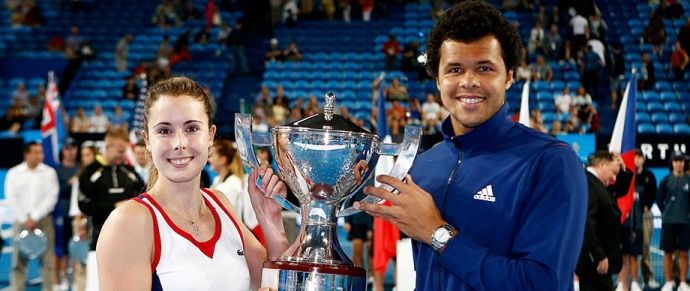
2013 - an interesting year!
Farewell to Marion!
Delightful Wimbledon Champion - Marion Bartoli - retires from tennis - photograph courtesy and copyright of Bob Martin / AELTC
We have a British Champion at last!
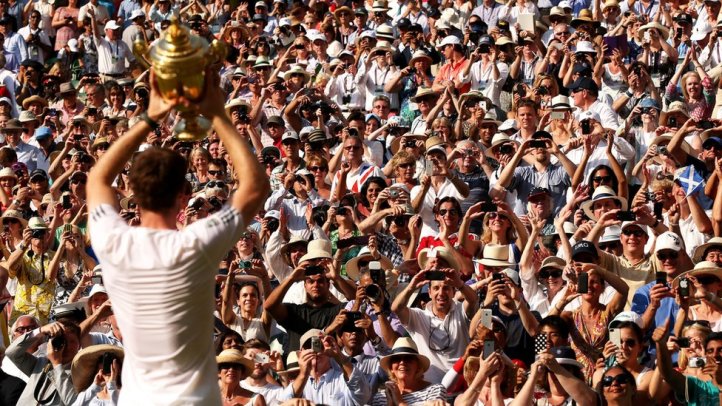
The Austin Rover Mini Advantage
How many cars are purpose-designed and named after a tennis score? The ever popular Classic Mini shines a beacon yet again. For more about the Advantage please visit here
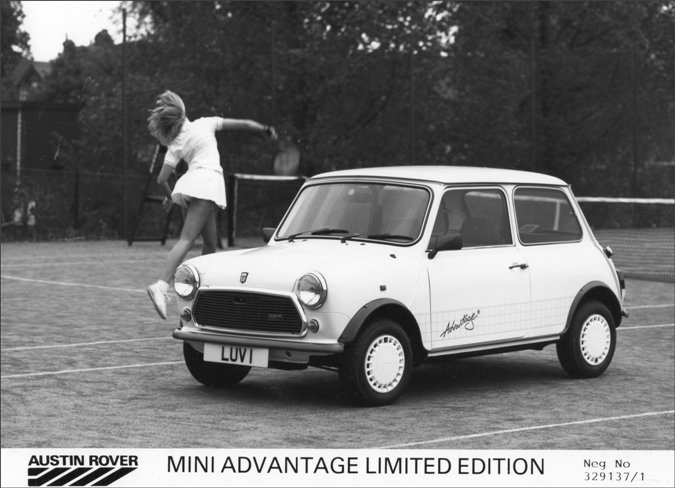
The official advertising plate from Austin Rover (formerly British Leyland)
London 2012 Olympics Wimbledon
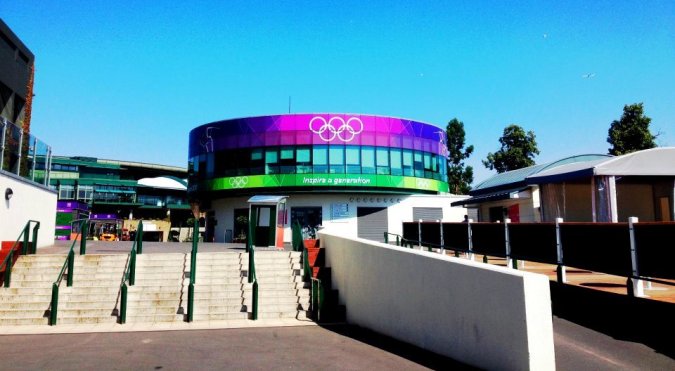
The Rainbow coloured entrance makes a very eye-catching image in the sun
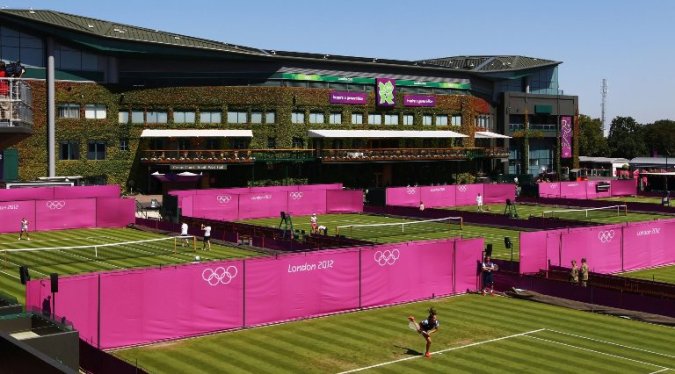
I really can't complain at the choice of Olympic colour for the transformed All-England Club.
(Olympic images courtesy of the All England Club and Getty)
The London Olympics fittingly brought two British Medals
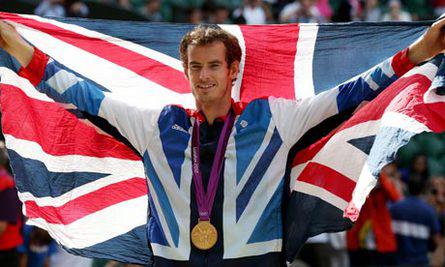
Murray flying the flag for Great Britain
The three proud medallists (l to r) Juan Martin del Potro (Bronze - Argentina) Murray (Gold - GB) and Roger Federer (Silver - Switzerland)
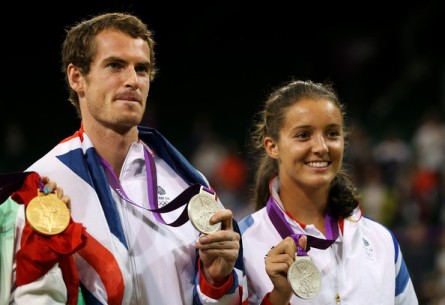
Proud silver medallists for GB in the mixed doubles - Andy Murray and Laura Robson
We are Tennis.com comes the Tennis World
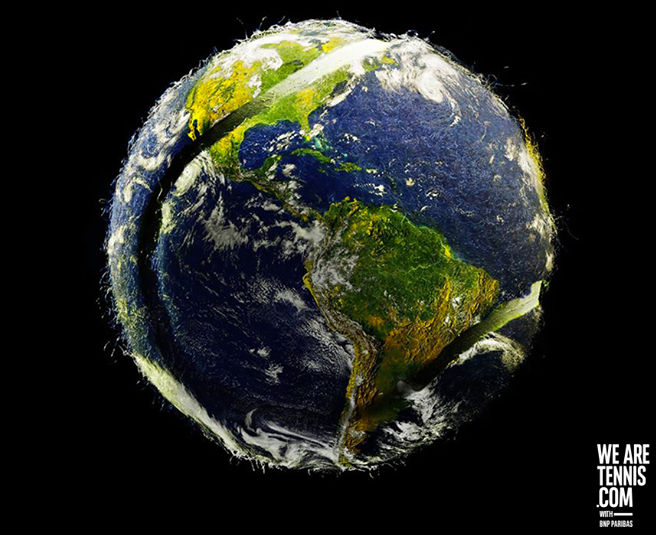
Fabulous image of World Unity!
WTA Artwork for the Brussels Open

Background image used on the WTA Brussels web-page.
Cartoon Murray
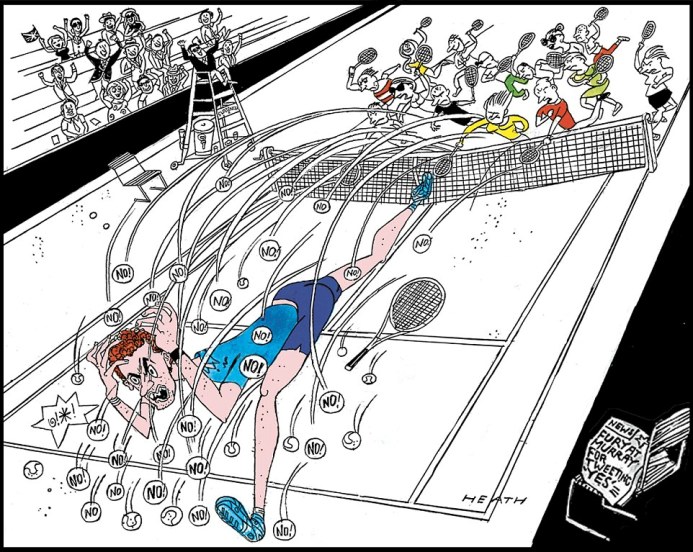
Oh dear - yes, we do feel like that and Heath creates it beautifully! And then they ask - will we ever love Murray?
Not so elegant are the faces pulled by Andy Murray which I can't help thinking remind me of the 'Mouth of Sauron' but to save him any embarrassment I'll only show two really great cartoons commissioned by the Daily Mail and executed by Trevillion.
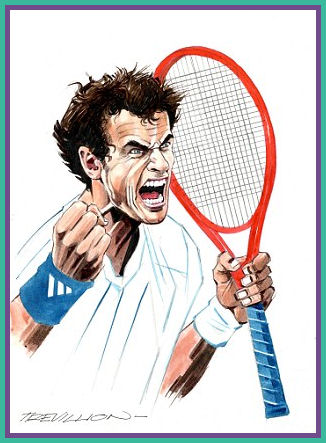
Maybe this artwork should have been part of a fascinating exhibition with a really good play on words entitled 'Court on Canvas' - this really appealed to me and opened my eyes to the vast spectrum of art on the subject of tennis available on canvas as a medium.
We are all accustomed to photographs of tennis players, action shots, modelling shoots, film footage, videos (as they were) DVDs and Blu-ray but the world of canvas which brings tennis alive has until now been a closed book to me.
I like this super-anti-hero (I don't really want to call a British player a villain, especially after we got used to the idea of 'Gentleman' / 'Practical Joker' Tim Henman once he'd stopped hitting ballgirls and getting expelled from Wimbledon) style of Andy Murray created by Trevillion because I have always liked the super-hero comics of the 1930s and the style which evolved from that - but to find the finesse and modernity of tennis on canvas from the whole of the 20th century is just plain fabulous! For the full article please visit here and for more on the Barber Institute which created the exhibition please visit here or got to You Tube for a quick stroll through the exhibition.
And now Spitting Image Murray
Poor Boris (Mophead) Johnson - what did he do to get included in this unsavoury line-up?
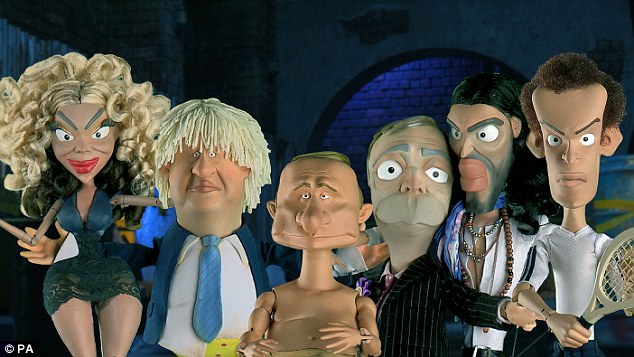
Those to be lampooned in the new show include, from left: Beyonce, Boris Johnson, Vladimir Putin, Nigel Farage, Russell Brand and Andy Murray - image courtesy of the Press Association and the Daily Mail
Court on Canvas
To whet your appetite, here are some of the spectacular examples of that formed part of the exhibition and why they particularly appeal to me!
What caught my eye particularly with this exhibition, other than I did not realise there was such 'distinguished' tennis art in existence (never too late to learn about these things), was the fact that both Eric Ravilious and Eric Gill are contributors. This led to the knowledge that Oliver Hill was also a big fan of tennis - even more to like about the Midland Hotel triumvirate of designers (and of course another of those spooky links)! But then I found that another contributor and prolific painter of tennis scenes was Spencer Frederick Gore who painted the Carreras Black Cat Factory which he could, as it happens, see outside of his living quarters on Mornington Crescent! Here are some examples of his 'tennis' work:
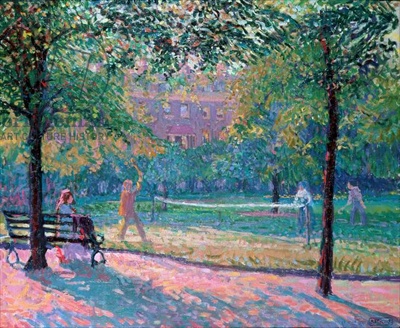
"The Game of Tennis"
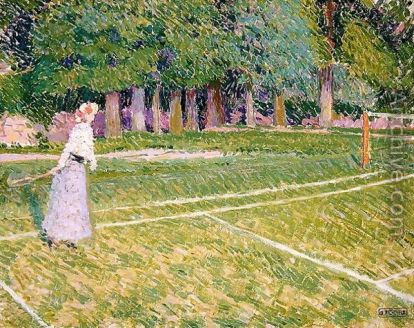
A woman player in all the restricting garments of the day!
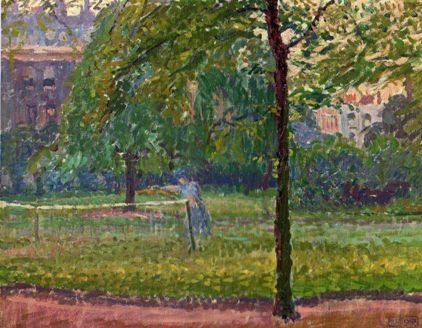
In the shade - very reminiscent of Gore's Mornington Crescent paintings.
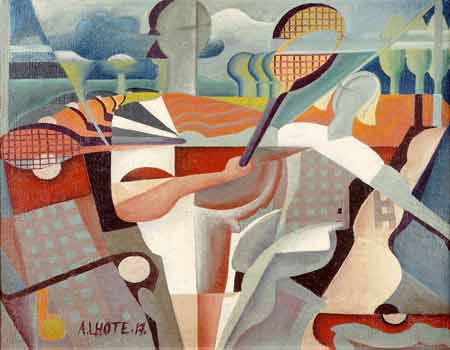
From André Lhote - 'Tennis Players' 1917 courtesy of the Wimbledon Lawn Tennis Museum
André Lhote - originally trained as a sculptor and then turned to painting. Initially he worked in the Fauvist style, but joined the Cubist movement in 1910. The first world war interrupted his career, but he was discharged in 1917 and soon afterwards produced this cubist view of Tennis Players.
Tennis in Art
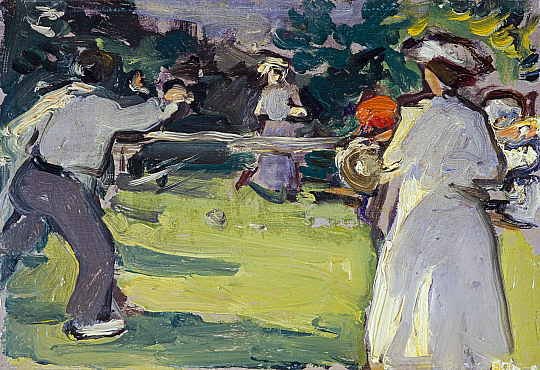
Labelled as 'Scottish Art' - Game of Tennis, Luxembourg Gardens 1906 - Samuel John Peploe
On searching further, beyond the Court on Canvas exhibition I found several other pieces of interesting art - my thanks to the National Gallery of Scotland for giving us this wonderful very early Peploe piece.
Samuel John Peploe (Scottish, 1871 - 1935)
Peploe is one of the group of four artists known as the 'Scottish Colourists.' Born in Edinburgh, he studied art in Paris and lived there from 1910 to 1912. It was through painting holidays in Northern France that he was introduced to the use of bold colour, inspired by the bright sunlight. He later experienced the same intensity of light while painting on the island of Iona, off the west coast of Scotland. French painting proved to be a powerful influence for Peploe throughout his life. Although his work never became abstract, it was characterised by tight composition, strong colour and assured handling.
Fergusson enjoyed travelling to France with his fellow colourists and we benefit with this lovely piece.
John Duncan Fergusson (Scottish, 1874 - 1961)
‘Scottish Colourist’ John Duncan Fergusson is recognised as one of the most influential Scottish painters of the 20th century. Mostly self-taught, he moved to Paris in 1907, where he became a member of the Parisian art circles to which artists such as Matisse and Picasso also belonged. The outbreak of the First World War forced him to return to Britain, and by 1918 he was an established member of the art scene in Chelsea, London. In 1929 he went back to Paris for a further eleven years before moving to Glasgow, where he lived until his death. Like his friend S J Peploe, Fergusson’s early work was influenced by that of Whistler and the Glasgow Boys, but in France he came across Fauvism and adopted a similar style, using pure, bright colours and bold, rhythmic contours.
Fred Perry 1909 - 1995
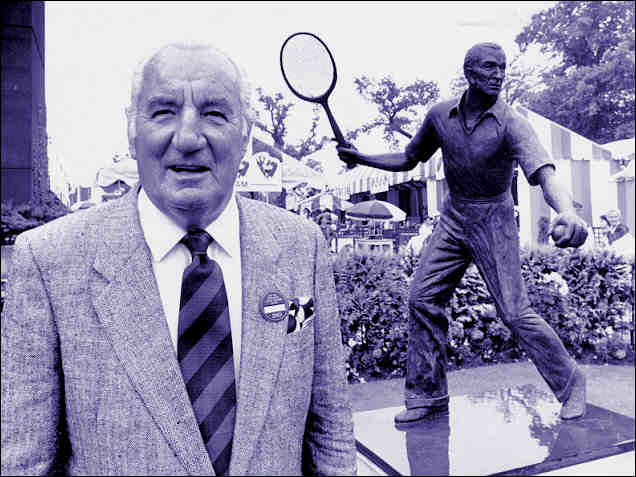
In 1984, with still no viable British player likely to wrest his Wimbledon crown, the great man himself, Fred Perry poses with the statue depicting his glory days, created to honour him and to celebrate his achievements.
Frederick John Perry
Born: 18 May 1909, Stockport Died: 2 February 1995 in Melbourne, attending the Australian Open
Claims to fame: Won Wimbledon on three successive occasions (1934, 1935 and 1936); the first man to win all four ‘grand slam’ titles – Wimbledon, Australian, French and American championships – though not in the same year
Playing style: immensely quick, with all-court ability; trademark shot a deadly ‘early-ball’ running forehand
Wimbledon record: reached semi final once in five attempts before 1934 and won mixed doubles twice
Other achievements: won a total of eight grand slam titles, three in the USA and one each in Australia and France. He also played a pivotal role as Britain won the Davis Cup four years running (1933–36)
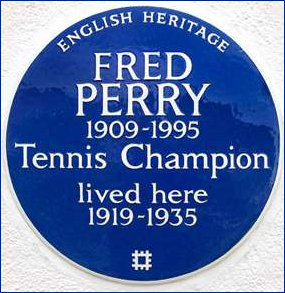
Plaque erected in 2012 by English Heritage at 223 Pitshanger Lane, Brentham Garden Estate, London W5 1RG, London Borough of Ealing. Details : "Profession : Tennis Champion | Category : Sport | Inscription : FRED PERRY 1909-1995 Tennis Champion lived here 1919-1935 | Material : Ceramic"
Fred Perry is the most successful male tennis player that Britain has produced, and one of the country’s few outstanding champions in any sporting discipline. Until Andy Murray’s triumph at the US Open in 2012, he was the last British man to win a Grand Slam event, and until Murray’s victory in 2013, the last British man to win Wimbledon.
LONDON BEGINNINGS
Although he was a northerner by birth, Perry’s formative years were spent at 223 Pitshanger Lane in Ealing, and it was while living here that he won his three Wimbledon titles. The house is part of the Brentham Garden Suburb, and dates from about 1906. As a child, Perry practised table tennis on the kitchen table, and honed his tennis shots in the garden, against the wall or the garage door. Perry played the game for real at the Brentham Institute (now the Brentham Club) in Meadvale Road, just a few streets away. Later, when commuting to his office job with the Co-op, Perry remembered he ‘used to continue practising my tennis strokes with the aid of my umbrella on the 20 minutes’ walk to Ealing Broadway Station, clipping the tops of hedges and flowers when nobody was looking.’
WIMBLEDON CHAMPION
Perry’s first global title came at the age of 19 when he became Table Tennis World Champion, but it wasn’t until he started fitness training with Arsenal Football Club (then managed by Herbert Chapman) in 1932 that he began to excel at lawn tennis. He went on to win the Wimbledon men’s singles titles in 1934, 1935 and 1936 – a hat-trick that was not achieved again for over 40 years. To his Wimbledon titles Perry added the men’s singles championships of the United States (1933, 1934 and 1936), Australia (1934) and France (1935). His French title, won on an unfamiliar clay court surface was, and remains, a unique achievement for a Briton.
TENNIS MAVERICK
By contrast to the sedate and well-heeled tennis establishment, Perry was in his own words ‘a rebel from the wrong side of the tennis tramlines’. His self-taught shots owed little to the textbook, and were often derived directly from table tennis. His sarcastic toff-baiting cries of ‘very clevah’ when an opponent played a good shot and his habit of vaulting over the net after he won a game made Perry compelling to watch. But his style was not conducive to universal popularity, or the approval of the British tennis establishment. Notoriously, following his first Wimbledon win, the club tie was left draped over a chair for him to pick up rather than presented to him formally, as was the tradition. He demanded – and received – an apology for this slight.
LONDON TO HOLLYWOOD
In 1936, Perry turned professional and moved to the United States. He took American citizenship soon after and was, for a time, part of the Hollywood set, though he was later reputed to say that he was ‘only American on paper’. During the Second World War Perry served in the US Air Force, but his competitiveness on the court declined following an elbow injury sustained in 1941. In 1950, with the businessman Theodore Wegner, Perry founded Fred Perry Sportswear. He kept busy in his later years by working as a tennis commentator and journalist, and it was after attending the Australian Open that Perry died, on 2 February 1995. A memorial service was held in his honour at St Paul’s Cathedral in London.
More from the BBC | Vice Sports
A Terrible Splendour
The harrowing biography of Gottfried von Cramm who as a confessed homosexual was shunned by society and persecuted by Adolf Hitler despite giving the sport one of its most exciting players - even the Wimbledon committee was uncomfortable with his personal status.
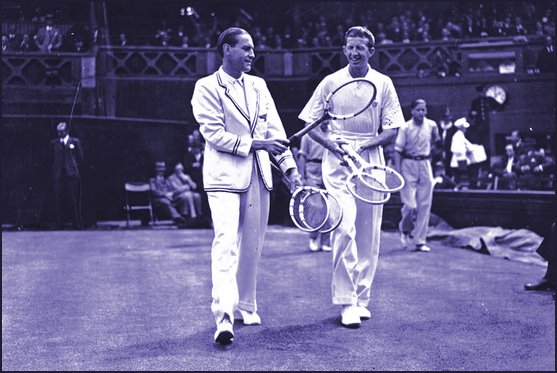
German Gottfried von Cramm, left, and American Don Budge take the court for the 1937 Wimbledon finals. They would play again two weeks later in Davis Cup competition. (Topical Press Agency/Getty Images)
The Four Musketeers
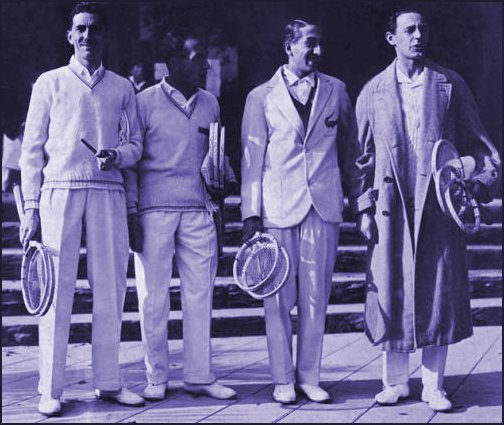
From left to right France's Four Musketeers - Jacques Brugnon, Henri Cochet, René Lacoste and Jean Borotra
The Dream Team of Tennis: The Four Musketeers by Alyce Vilines, GEM Tennis
Every sport has their Dream Team- that one unforgettable lineup of players whose grit and fierce determination allow them to break through impenetrable barriers, leap over unimaginable hurdles, and fight through impossible odds-sealing their fate and legacy in the minds and hearts of ardent fans.
Who can forget the brilliance of the US men’s basketball team in the 1992 Olympics in Barcelona or the passionate play of the 1980 US Olympic hockey team? How about the inspirational four-member Jamaican bobsled team who overcame all odds to bring home the gold, or the young and inexperienced Brazilian soccer team who swept through the competition to capture the 1962 World Cup?
In tennis, where legends typically achieve their glory in singular fashion, it can be more of a challenge to recall a group of players whose combined talents are of such memorable stature. . . with one exception.
The Four Musketeers, a troupe of outstanding French tennis players who dominated the sport in the late 1920’s through the early 1930’s, achieved Dream Team status long before the term had even been coined. Their unprecedented achievements and invincible spirit were certainly the stuff of which dreams are made, yet it took an American-born competition to make their Dream Team a reality.
The brainstorm of Harvard student, Dwight Filley Davis, the Davis Cup competition was first played in 1900, on the courts of Boston’s Longwood Cricket Club. Designed to provide tennis players with the unique opportunity for a team experience, the Davis Cup founders encouraged other countries to assemble national teams of their most talented players. These teams would then compete against one another for a coveted silver bowl, and more importantly, the honour of representing their nations.
In 1904, France became the third team to join the Davis Cup competition, along with Great Britain and the United States. Twenty-three years later, the revered contest included representative teams from more than 20 nations, including an impressive foursome from France. The celebrated French team of Jean Borotra, Jacques Brugnon, Henri Cochet and René Lacoste were among the talented players who, in 1927, arrived at the grass courts of the Germantown Cricket club in Philadelphia to compete for the Davis Cup title.
The nickname given to this talented foursome was fittingly derived from the band of compatriots in Alexander Dumas’ novel, The Three Musketeers, whose motto- “all for one and one for all”- accurately portrayed the close bond shared by these extraordinary athletes.
For three agonizing years, this gritty troupe of Frenchman had battled unsuccessfully to upstage the reigning American champions (who had held the title since 1920), finishing a heartbreaking second in 1925 and 1926.
On that fateful day in 1927, however, their resilience and fortitude finally paid off. In a victory which sent shock waves throughout the sports world, the Four Musketeers snatched the silver bowl from the Americans and the Dream Team of tennis was born. Even before the excited teammates had the chance to pass around the silver cup, plans were underway in Paris to build a new stadium that would house the Davis Cup rematch the following year.
In 1928, upon completion of the magnificent Roland-Garros facility, the French Federation of Tennis wanted to honour these four tennis greats. The answer was easy. The Men’s Singles trophy for the French Open tournament was named the “Coupe des Mousquetaires” (Cup of the Musketeers), a tribute befitting the inspiration they had provided in making this grand clay court stadium a reality.
Together they made history, but Borotra, Brugnon, Cochet and Lacoste were exceptional tennis players in their own right.
Jean “The Bounding Basque” Borotra (1898-1994), his trademark blue beret seated securely on his head, battled his opponents and entertained his fans with a coffer of unconventional ground strokes, lightning speed, and brilliant volleys. He captured the singles title at Wimbledon twice- in 1924 and 1926- and repeated the same at the French Championships – in 1924 and 1931. He was also the Australian Open Champion in 1928 and a finalist in the United States Championships in 1926. His greatest victory, however, may have come at the 1932 Davis Cup competition. Borotra was called out of retirement (at the age of 34) to replace his ailing friend, René Lacoste, in a match against the US Davis Cup team’s Ellsworth Vines. Borotra’s superb play, and ultimate defeat of this young American, clinched the Davis Cup win for France for the sixth year in a row, and for the last time for another 59 years.
Jacques “Toto” Brugnon (1895-1978) was the elder member of the Four Musketeers, and the only one who did not capture a major singles title. His gifted play at the net made for a completely different story in the doubles arena, however, where he notched one Australian, four Wimbledon, and five French doubles championships during his successful tenure on the courts. His Davis Cup doubles victories totalled an impressive 22 out of 31.
Henri “The Ballboy of Lyons” Cochet (1901-1987), considered by some to be the greatest French tennis player of all time, was a man of small stature and looming capability. At a mere 5’6”, this diminutive Frenchman used his grace and speed on the court to overpower his taller competitors. His ability to reach the ball early, coupled with his masterful execution of volleys, kept his opponents continually off-guard and ultimately ranked him as the world’s number one player from 1928-1931. Cochet captured one US, two Wimbledon and five French championship titles, in addition to his many victories ( 44-14 overall) in Davis Cup competitions between 1927 and 1932.
René “The Crocodile” Lacoste (1904-1996) was perhaps the most memorable of the “Four Musketeers”, noted as much for his off-court presence as for his feats on the court. Though a late bloomer (he didn’t pick up a racket until age 15), Lacoste quickly made up for lost time, participating on the Davis Cup team for the first time at the tender young age of 18. His relentless training and tactical genius ranked him #1 in the world in 1926 and 1927, and netted him seven major singles titles- three at the French Open, two on the grass lawns at Wimbledon and three more at the US Open. Off-court, he parlayed his popularity and flare for fashion into the infamous and enduring Lacoste clothing label.
The magical combination of this fabulous foursome who, in the words of René Lacoste, “crossed and recrossed the Atlantic seven times” in their endless quest for the prestigious Davis Cup title, earned them far more than the coveted silver bowl. Their passion and guts gifted their homeland, and tennis fans everywhere, with a Dream Team whose story will continue to inspire for generations to come.
Page updated : 27th September 2020 (G)
